[Flowers with long flowering period] More than 100 common flower plants_Flowers with long flowering period
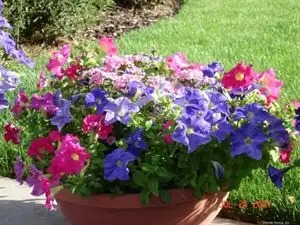
001. Petunia Proper name: petunia
Solanaceae Petunia
Alias: Petunia, hybrid feather morning glory, Lingzhi peony, Shuttlecock flower, dwarf trumpet, sweet potato flower, feather morning glory
Perennial herb, often cultivated as one or two years, flowering period from April to the end of October, if the indoor temperature reaches 15 degrees or above, it can bloom all year round.
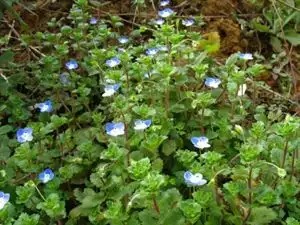
002. Arabian Veronica
Scrophulariaceae Veronica genus Also
known as: Persian Veronica
One to two years old herb, flowering period: February-May, grows everywhere, more common in the south, grows in fields and roadsides, is a common weed in early spring in East China; distributed in Anhui, Zhejiang, Jiangsu, and western Jiangxi. It is also a common invasive plant, native to West Asia and Europe.
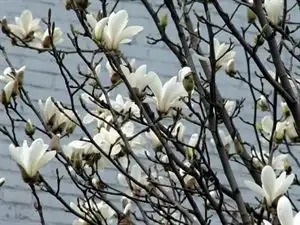
003. Magnolia
Magnolia Magnoliaceae Magnolia
Alias: Magnolia, Magnolia, Jade Tree, Winter Jasmine, Spring, Yingchun Flower, Yutangchun, Magnolia
Language: Pure love, sincerity.
Deciduous tree. Blooms in March, fruits ripen in June-July. White, large, fragrant flowers, bloom before leaves, flowering period of about 10 days. Famous flower tree, important ornamental tree in early spring in the north. Shanghai city flower. With a cultivation history of about 2,500 years, it is a precious ornamental tree in the garden. Distributed in the central and southwestern regions, it has been introduced and cultivated all over the world. Usually propagated by sowing and grafting. Prefers warm, sunny, moist and well-drained places, requiring fertile soil without water accumulation.
Another: Magnolia dahurica variant Yingchunhua, tree, the flower is light red inside, purple-red on the surface, and has fragrance. Common name: Purple Magnolia
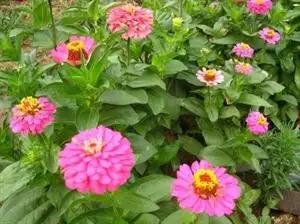
004. Zinnia Asteraceae
Zinnia genus
Other names: Zinnia, Step by Step, Fireball Flower, Five-color Plum, Opposite Leaf Chrysanthemum, Autumn Luo, Step Up It
is an annual herbaceous flower, flowering from June to September, and is the national flower of the United Arab Emirates. Native to the Mexican Plateau in North America. Currently distributed all over the world. It is a common material for flower beds and borders. The tall varieties are suitable for cut flower production.
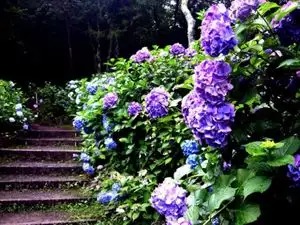
005. Hydrangea
Plants of the genus Hydrangea in the family Saxifragaceae
are also known as: hydrangea, fighting ball, grass hydrangea, purple hydrangea, and purple
hydrangea. It is a deciduous shrub 3-4 meters high and blooms from June to July. Its flowers can be red or blue, which is pleasing to the eyes and refreshing. It is a common potted ornamental flower. It is native to the Yangtze River Basin and is now cultivated all over the country. Commonly cultivated variants include big hydrangea, cone hydrangea, purple stem hydrangea, toothed hydrangea, blue-edged hydrangea, silver-edged hydrangea, and creeping hydrangea.
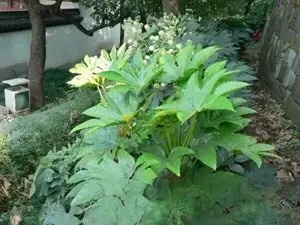
006. Flavescentis
Araliaceae Flavescentis genus
Alias: eight hands, hand tree
evergreen shrub or small tree, up to 5 meters high. The flowering period is from October to November, and the fruit ripening period is April of the following year. It is native to the mountain forests near the sea in warm areas of Japan. It was introduced in the early years and is now widely cultivated in the areas south of the Yangtze River for urban greening and garden ornamental purposes, especially in Taiwan.
In addition: It is very shade-tolerant and is often cultivated under overpasses. It can also be used as cut leaves and applied to places such as opening flower baskets.
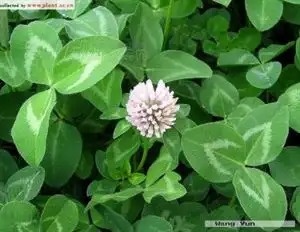
007. Trifolium genus
of the Leguminosae family
Aliases: white clover, white clover, white clover, clover, white clover
The national flower of Ireland. It is a perennial herb first cultivated in the Netherlands in the late 16th century and is now widely distributed in temperate regions. There are mainly two types, namely white clover and red clover. Clover is a high-quality leguminous forage grass with fine stems and leaves, abundant leaves, high crude protein content, and low crude fiber content. It can be used to graze livestock and feed herbivorous fish.
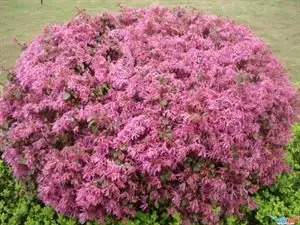
Loropetalum
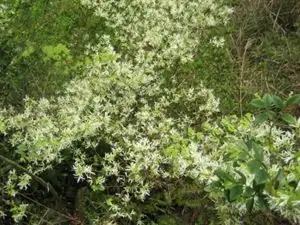
scabra
008. Loropetalum scabra,
Hamamelidaceae, Loropetalum genus,
alias: shackle firewood, [Loropetalum] successor flower, hard lacquer, fish bone firewood, [Loropetalum] successor tree, thorny wood flower, white
shrub all over the mountain, rarely small trees, flowering in May, fruiting in August. Produced in Suzhou, Wuxi, Yixing, Liyang, Jurong and other counties, growing in hillside dwarf forests; distributed in East China, South China, Southwest China provinces and regions. Roots, leaves, flowers, and fruits are used as medicine, which can relieve fever, stop bleeding, and promote blood circulation; the wood is solid and durable; the core and leaves contain tannins, which can extract tannin.
Another: There is also Loropetalum scabra, a flower and leaf ornamental plant. Loropetalum scabra has luxuriant branches and leaves, various tree shapes, flexible wood, and is resistant to pruning and twisting. It is a good material for making tree stumps for landscape. It is also graceful when planted on the ground, and is a precious ornamental tree species for beautifying parks, courtyards, and roads.
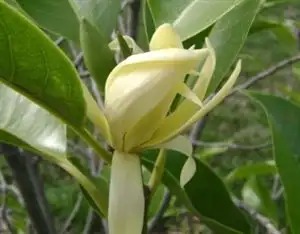
009. White
orchid Magnolia Magnoliaceae Michelia
Alias: yellow orchid, white Burmese laurel, white orchid,
orchid Deciduous tree, long flowering period, blooming continuously from June to October. Native to the Himalayas. Now cultivated in Beijing and the south of the Yellow River Basin. In ancient times, it was mostly planted in front of pavilions, terraces, towers, and pavilions. Now it is often seen in gardens, factories and mines, planted alone, scattered, or as a street tree on both sides of the road. There are also piled landscape potted plants in the north. It is a good anti-pollution greening tree species in air polluted areas.

010. Lily Bamboo
Agavaceae Dracaena
Alias: short-leaved cordyline
evergreen shrub, foliage plant, native to Madagascar, now widely cultivated as a foliage plant.
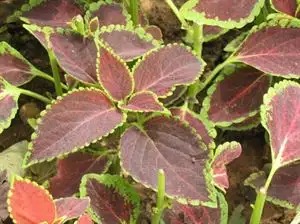
011. Coleus Lamiaceae
Coleus Alias
: old and young, five-color grass, coleus, foreign perilla
Perennial herb, foliage plant. Native to the tropical Asia-Pacific region, Java, Indonesia. Now widely cultivated in countries around the world.
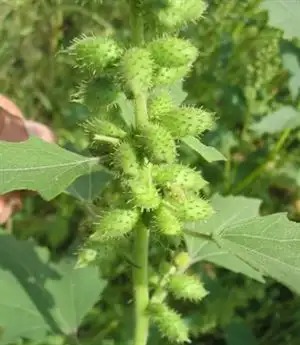
012. Xanthium
Asteraceae Xanthium genus
Alias: Dull ear, also known as Hu, Changsi, Juaner, Jueer, Zhuer, Ear, Dikui, Sheep Fulai
Annual weed, widely distributed in most of Europe and parts of North America. Produced in various places, native to America and East Asia, widely distributed in most of Europe and parts of North America; grown on hillsides, grasslands, and roadsides. Widely distributed in various places. The fiber made from the stem bark can be used to make sacks and hemp ropes. Xanthium seed oil is a raw material for high-grade spices, and can also be used as paint, ink and soap hardening oil, etc., and can also replace tung oil. It is used as medicine to treat leprosy, and the seeds are diuretic and sweating.
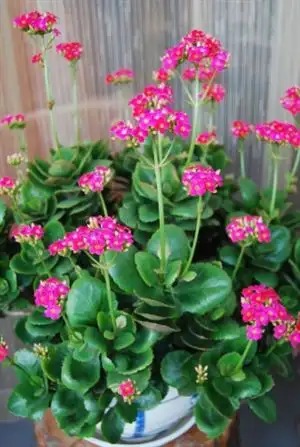
013.
Kalanchoe Crassulaceae Kalanchoe genus
Alias: Dwarf Kalanchoe, Christmas Kalanchoe, Longevity
Flower Flower language: Good luck, longevity, longevity and happiness
Perennial fleshy herb, flowering period is from December to the end of April before the New Year. Native to Madagascar. Colors include scarlet, pink, orange-red, yellow, orange-yellow and white. One of the fastest growing potted flowers in the international flower market.
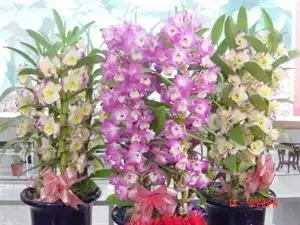
Spring Dendrobium
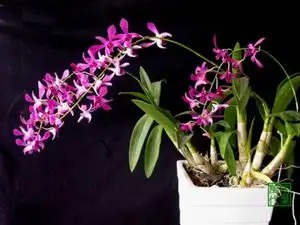
Autumn Dendrobium
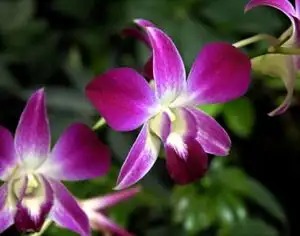
Close-up of Autumn Dendrobium
014. Spring Dendrobium
Orchidaceae Dendrobium Genus
Also known as Beautiful Flower Dendrobium
Flower language: Flower of success, people often present it to their beloved elders.
Perennial epiphytic orchid. The ancestor of Spring Dendrobium is Dendrobium nobile, which is native to China. It was first introduced to Europe from Britain for cultivation and was improved and bred. Spring Dendrobium can be divided into three major series according to color: red flower series, white flower series, and yellow flower series, and each series has different varieties. One of the famous New Year flowers.
In addition: Dendrobium orchids are divided into two types, one is Spring Dendrobium, namely the Nobile series, which blooms in spring and the pedicels are drawn out from the stem nodes on both sides. The other type is the autumn dendrobium, which blooms in autumn. The pedicels emerge from the top of the stem, and each stalk can have up to 10 to 20 flowers. The flower shapes include large-flowered Phalaenopsis type (Phalaenopsis series) and small-flowered curly petals.
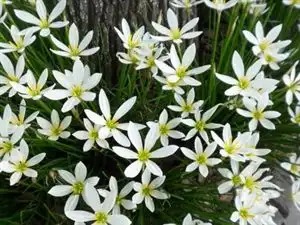
015. Allium
amaryllis, Amaryllis family, Allium genus
, Alias: Lotus, Jade Curtain, White Flowered Acorus Lotus,
a perennial evergreen bulbous flower. Native to America, it is the most common ground cover plant in the Jiangnan region. It has a long flowering period and is often used as a border material for flower beds. It is also suitable for planting in green areas. It is most suitable as a ground cover plant in the semi-shaded area under the forest, or planted beside the paths in the courtyard.
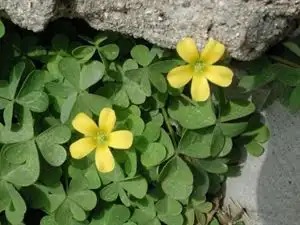
Yellow Oxalis ,
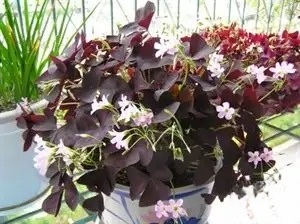
Purple Oxalis,
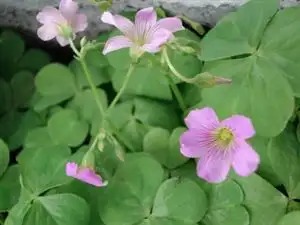
Red Oxalis
016. Yellow Oxalis,
Oxalis family, Oxalis genus, a perennial herbaceous bulbous plant .
Alias: Physalis, Sour Grass, Dove Acid, Trifoliate Acid, Sour Mimi,
perennial herbaceous plant. The flowering period is from May to July. It is widely distributed, growing in roadside grass or fields, in front of and behind houses. It is distributed in all parts of the north and south.
There are also red Oxalis and purple Oxalis.
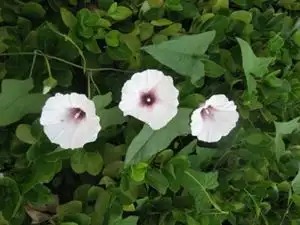
017. Convolvulaceae Convolvulaceae
Convolvulaceae
Alias: small bindweed, rabbit ear grass
Perennial herb. Flowering period: May-June, fruiting period: July-August. Found all over the country. Often seen in fields, roadsides, streams and bushes.
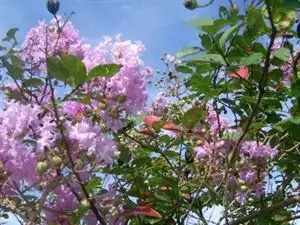
018. Lagerstroemia
Lythraceae Lagerstroemia
Alias: 100-day red, full house red, itchy tree
Deciduous shrub or small tree. The flowering period is very long, from June to September, so it is called "100-day red". It is native to southern Asia and northern Australia. It is distributed in East China, Central China, South China and Southwest China, and is widely cultivated in various places.
Lagerstroemia varieties (1) Lagerstroemia: flowers are purple-red.
(2) Cuiwei: flowers are blue-wood color, and leaves are dark green.
(3) Chiwei: flowers are fiery red.
(4) Yinwei: flowers are white or slightly light cocoon color, and leaves are light green.
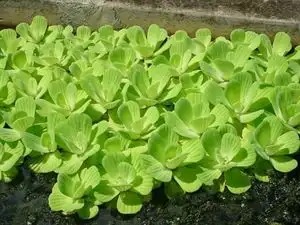
019. Dapiao
is also called Dapiao, Araceae Dapiao genus.
Perennial and annual herb. With creeping stems; rosette-shaped leaves, sessile, floating on the water; fleshy spadix, white spathe. Distributed in provinces south of the Yangtze River. Grown in ponds or cultivated artificially as feed.
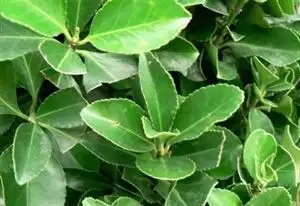
020.
Euonymus genus, Euonymus of the family Euonymus
alias: holly euonymus, righteous wood, fumigate, evergreen, seven-lixiang, Japanese euonymus.
Evergreen shrub or small tree, widely cultivated in various provinces for ornamental purposes; this species is extremely resistant to pruning and is a good hedge material.
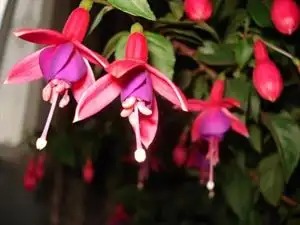
021. Fuchsia
Onagraceae, Fuchsia genus
alias: hanging bell crabapple, hanging bell flower, lantern crabapple
semi-shrub or small shrub, flowering period April-July. Native to Peru, Chile, Argentina, Bolivia, Mexico and other Central and South American countries, now widely cultivated. There are many horticultural varieties, with single petals and double petals, and the flower colors include white, pink, orange, rose purple and eggplant purple. Some plants are low and have flat branches, suitable for potted plants; some have thick branches and do not spread out; there are also a few foliage varieties.
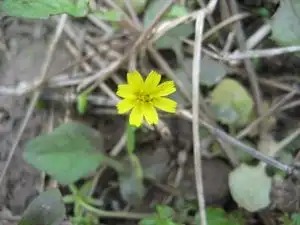
022. Rice-leafed
radish Asteraceae Rice-leafed genus
Annual herb, farmland weeds. Suitable for ground cover materials.
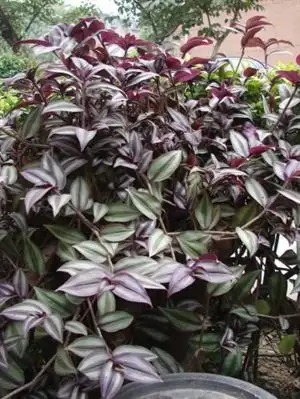
023. Hanging bamboo
plum Commelinaceae Commelinaceae genus
Alias: hanging bamboo orchid, spotted leaf Commelinaceae
Perennial evergreen herb, native to Mexico. Small potted plants. Growing quickly, can cover the entire pot in one year, with creeping and drooping branches and leaves, purple, green, and silver, dazzling. Place it on a high shelf or cabinet top and let it droop naturally, or you can hang it in a pot for appreciation. Or arrange it above the windowsill to make it droop, forming a green curtain. It is often used for overall layout in courtyard cultivation.
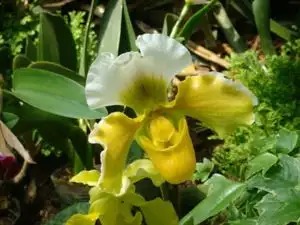
024. Paphiopedilum
Orchidaceae Paphiopedilum genus
Alias: Slipper orchid
Perennial evergreen herb, one of the most primitive groups in the orchid family. Originally grown under trees in tropical and subtropical areas, most of them are terrestrial species, a few are epiphytic species, and there are many hybrid varieties now. It is mainly distributed in tropical areas of India, Myanmar, Indonesia, Guinea and other countries in southern Asia, as well as in the southwest of China. Paphiopedilum is rich in plant resources, with 18 known species, mainly distributed in the southwest and south China. It is one of the earliest and most popular orchids cultivated in the world. Its plant shape is graceful, the flower shape is peculiar, the flower color is rich, and the flowers are large and colorful. It is very suitable for potted ornamental plants and is an excellent high-end indoor potted ornamental plant. Its flowering period is long, and the blooming time of each flower is as short as 3 to 4 weeks and as long as 5 to 8 weeks.
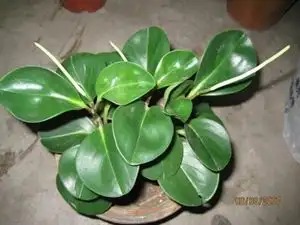
025. Peperomia Peperomia
, Piperaceae,
alias: Peperomia
perennial herb. Originally produced in the West Indies, Panama, and northern South America.
The main horticultural varieties are (1) variegated leaf Peperomia, with red spots on the stems, dark green leaves, and yellow spots on the edges, which later turn almost white; (2) Green Gold, with yellow spots on the leaves. Small potted plants. It is often planted in white plastic pots or white porcelain pots, and placed on coffee tables, decorative cabinets, antique shelves, and desks, which are very beautiful. Or let the branches spread and hang down, and hang them in front of indoor windows or bathrooms, which are also very fresh and pleasing to the eye.
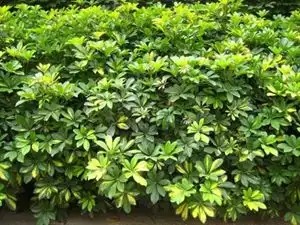
026. Schefflera
Araliaceae, Schefflera genus.
Alias: hand tree, duck foot wood, small-leaved umbrella tree, dwarf umbrella tree, Scheffler's wood. It is
an evergreen shrub, native to subtropical rain forests such as the South Pacific Islands, Guangdong, and Fujian, and also distributed in Japan, Vietnam, and India. It is now widely planted all over the world. It is an excellent potted plant. Suitable for arranging living rooms, study rooms, and bedrooms. It can also be placed in the shade of the courtyard and on the balcony of the building for viewing in spring, summer, and autumn. It can also be planted alone in the courtyard, and it is a nectar plant in the south in winter. The leaves and bark can be used as medicine.
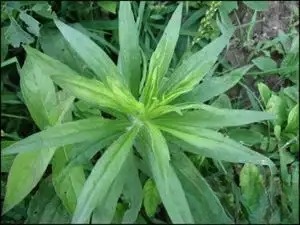
When it is an
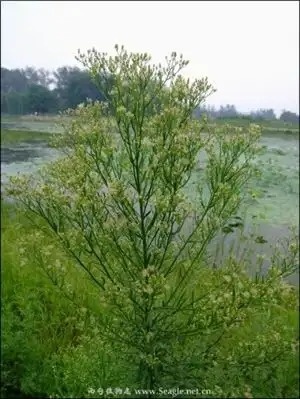
adult, it is recorded in the year
. 027. Erigeron
pyralis Asteraceae Erigeron genus
Alias: small white wine grass, small flying lotus
biennial or annual herb. Distributed in Northeast China, Shaanxi, Shanxi, Hebei, Henan, Shandong, Zhejiang, Jiangxi, Hubei, Sichuan, Taiwan and other provinces. Mainly harm cotton, wheat, fruit trees, vegetables, etc. Grown on river beaches, canals, roadsides or farmlands, it is easy to form large communities.
[Functions and indications] Clear away heat and dampness, disperse blood stasis and reduce swelling. Enteritis, dysentery, infectious hepatitis, cholecystitis; external use for psoriasis, traumatic injuries, sores, swelling, rheumatism, bone pain, traumatic bleeding; fresh leaves are mashed into juice to treat otitis media and conjunctivitis.
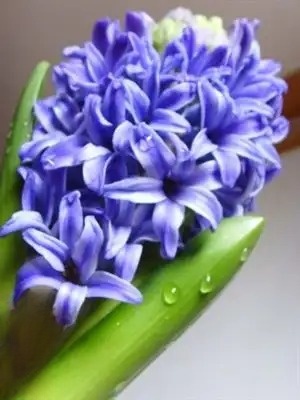
028. Hyacinthus
Liliaceae Hyacinthus genus
Alias: Narcissus, five-color narcissus
perennial herb with bulbs. Hyacinthus bulbs have the habit of dormancy in summer, take root in autumn and winter, sprout new buds in early spring, bloom in March, and the plants wither in early June. Hyacinthus is native to the Mediterranean and South Africa. So far, cultivated hyacinths have begun to enter the interior decoration and display of homes and public places, and the demand is increasing year by year. However, it has not yet been able to reproduce on its own and still needs to be introduced from abroad.
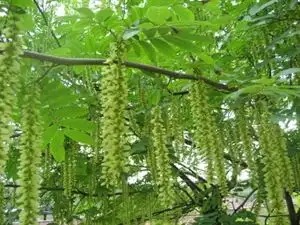
029. Maple
Poplar Juglandaceae Maple Poplar genus
Alias: Ping Liu, Ma Liu, Shui Ma Liu, Chicken Tree, Maple Willow, Centipede Willow, Flat Poplar Willow, Swallow Tree, Yuanbao Tree.
It is a large deciduous tree, up to 30 meters high, with small nuts and wings at both ends. It blooms in May and ripens in September. It is a native tree species. It has been cultivated and utilized for hundreds of years and is now widely distributed in North China and South China, and is most common on both sides of rivers and streams.
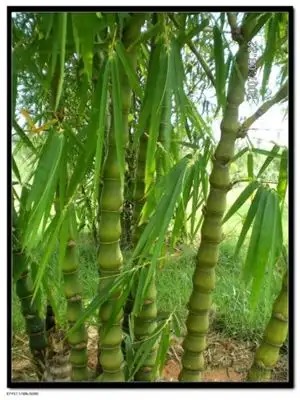
030. Buddha Belly Bamboo
Poaceae Bamboo genus
is also known as Buddha bamboo, Luohan bamboo, dense bamboo, big belly bamboo, gourd bamboo.
The leaves are evergreen, and the internodes are swollen, shaped like a Buddha's belly, so it is named Buddha's belly bamboo. Buddha's belly bamboo is a specialty of Guangdong and is a good material for potted plants and bonsai.
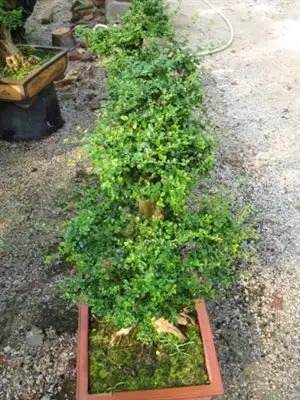
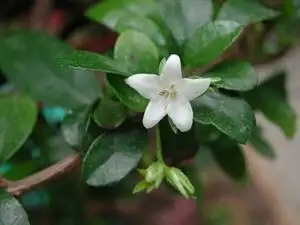
Flowers
031. Fujian Tea
Boraginaceae, genus Kijishu
Alias: Kijishu
Evergreen shrub, small white flowers in spring and summer, one of the main varieties in the production of Lingnan bonsai. It can also be placed in the garden for viewing. Due to its strong growth and tolerance to pruning, it is often planted as a hedge in the Minao area.
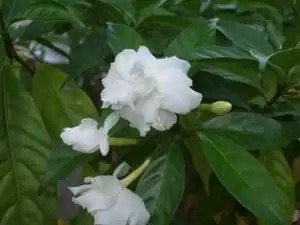
032. Dogtooth Flower
Apocynaceae Dogtooth Flower
Other names: Horse Hoof Fragrance, White Dog Flower, Lion Flower, Tofu Flower
Evergreen shrub, flowering period May-November, this flower has lush green leaves, crystal white flowers and elegant fragrance, it is an excellent potted flower. Dogtooth Flower is native to the southern coastal provinces.
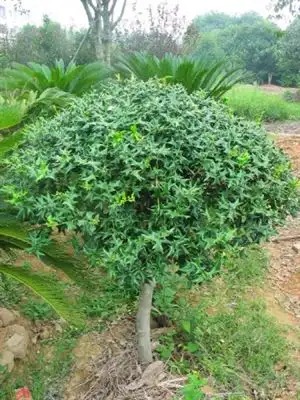
033. Holly
Alias: Bird's Nest, Cat's Thorn
Evergreen shrub or small tree. Bark is grayish white. Leaves are square with sharp and hard thorns, hard leathery, green, shiny, and light green on the back. Cymes, yellow-green, clustered in the axils of 2-year-old twigs, flowering from April to May. Drupes are spherical, bright red when ripe, and fruiting from October to November. Produced in Nanjing, Jiangning, Zhenjiang, Yixing, Wuxi, Suzhou, Shanghai and other places, growing in bushes on hillsides and valleys; now often cultivated in gardens everywhere; distributed in provinces in the middle and lower reaches of the Yangtze River.
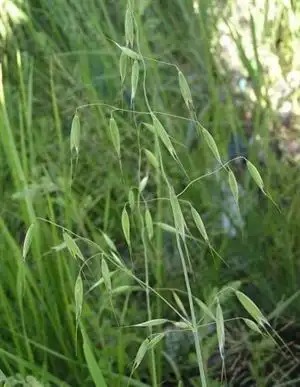
034. Wild oats
Poaceae Avena genus
Other names: oat grass, bell wheat, black wheat.
Annual mesopsis. Native to the Mediterranean region of southern Europe; now widely distributed around the world. This species is a global malignant farmland weed, which may have been introduced with imported wheat. Specimens were collected in Hong Kong and Fuzhou in the mid-19th century. It has now become a common weed, harming crops such as wheat, corn, sorghum, potatoes, rapeseed, soybeans, and sesame; at the same time, a large number of seeds are mixed with crops, reducing the product quality of the crops.
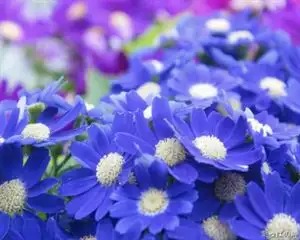
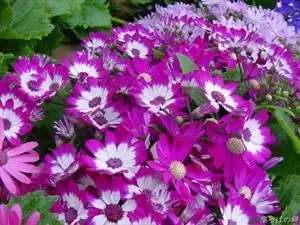
035. Cineraria
Asteraceae Cineraria
Other names: Globe aurea, citronella, and Senecio.
Perennial herb, often cultivated as a 1-2 year old plant. The flowers are rich in color, with all colors except yellow, and red and white mixed colors. The flowering period is from January to April. It is native to the Canary Islands in Spain. It likes cold weather and is not resistant to high temperatures and frost. It likes fertilizer and prefers loose, well-drained soil.
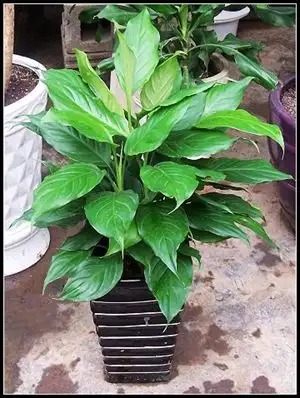
036. Guangdong Dieffenbachia
Araceae, Genus Araceae
Other names: rough rib grass, bright silk grass, Guangdong Dieffenbachia.
A perennial evergreen herb native to China and Japan. The main production areas are Zhejiang, Jiangxi, Hubei and other places. It likes to grow in wet places under forests or in grasslands. Common and important ornamental varieties include: Golden Edge Dieffenbachia (leaves with yellow edges); Silver Edge Dieffenbachia (leaves with white edges). In addition, there are variants such as variegated leaves, large leaves, fine leaves, and dwarf leaves.
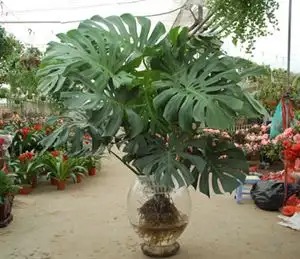
037. Monstera
Araceae Monstera
Other names: Monstera, Electric Wire Orchid, Wire Orchid, Perforated Philodendron
Araceae evergreen climbing foliage plant, with brown aerial roots on the stems, shaped like electric wires, hence the name "electric wire grass". The leaves are oval, with many oblong holes and deep cracks in the shape of a tortoise shell between the pinnate veins, and its shape resembles a tortoise shell pattern. The stems have nodes like bamboo trunks, hence the name "Monstera". The spadix inflorescence, the whole flower shape is like a "table lamp", with a lampshade and a bulb, very peculiar. Monstera is native to the tropical rain forests of Mexico. It likes a warm and humid environment, avoids direct sunlight, and is not cold-resistant. It is used as an indoor potted plant in the north.
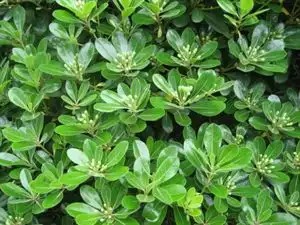
038. Pittosporum
Pittosporaceae, Pittosporum
Other names: Pittosporum flower, mountain alum
Evergreen shrub or small tree, flowering in May, fruiting in October, capsule ovoid, angular, split into three petals when ripe, revealing bright red seeds. The flower is fragrant, with 5 petals and 5 stamens. Produced in southern Jiangsu, Zhejiang, Fujian, Taiwan, Guangdong and other places; also distributed in North Korea and Japan. Commonly cultivated for ornamental purposes in the gardens of the Yangtze River Basin and south of it.
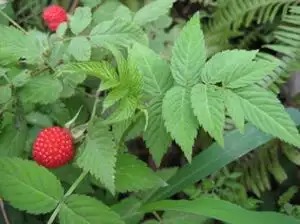
fruit
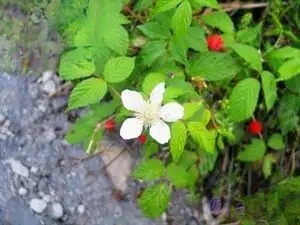
Flower
039. Pengsu lěi
Rosaceae Rubus
Wild strawberry, big waterberry, Gegu, Gugong, Gagong (our local name), Guogong, Mengzi, etc.
It is shaped like a strawberry, bright red, hollow in the middle, and has white flowers. It blooms in April and fruits in May. It tastes very tempting. It grows on hillsides, in the wild, and in the grass; it is distributed in Zhejiang, Jiangxi, Fujian, Taiwan, Guangdong, Yunnan and other provinces. The fruit is sweet and sour and edible; the whole plant and roots are used as medicine to clear away heat and detoxify.
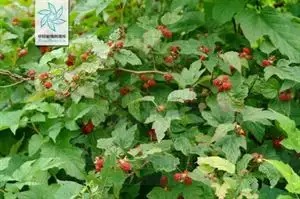
040. Raspberry
Rubus genus, Rosaceae
Other names: raspberry, malin (called red raspberry flower in Russia), commonly known as malin fruit in Northeast China. We call it Shangagong locally.
Deciduous or evergreen shrubs, subshrubs, or herbs. Stems are climbing or upright, most with prickles. There are more than 450 species in the world, mainly distributed in the cold and temperate zones of the northern hemisphere. There are about 210 species, wild in various parts of the north and south.
Functions and indications: tonifying the kidney, consolidating sperm, and reducing urine. Used for kidney deficiency and enuresis, frequent urination, impotence and premature ejaculation, and spermatorrhea.
In addition: The difference between raspberries and sedge is that raspberries are generally upright trees, while sedges are creeping on the ground. The fruit of raspberries is relatively small, tastes relatively sour, and the color is not as bright red as sedges, and the middle is solid.
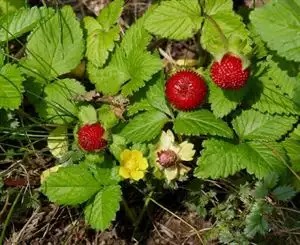
041. Duchesnea
Ducosa genus, Rosaceae
Perennial herb, the whole plant has soft hairs; long stolons. Flowering season is April, fruiting season is May. Produced throughout the province, wild on hillsides, roadsides, ditches or weeds on ridges; distributed throughout the country. The whole plant is used for medicinal purposes, with the effects of clearing away heat and detoxification, promoting blood circulation and dispersing irritation, astringing and stopping bleeding, and can also treat snake bites, boils, etc.; and is used to kill mosquito larvae and fly maggots
In addition: The difference from the previous two is that: first, it is not delicious, second, there are no thorns on the vine, and the flowers are yellow.
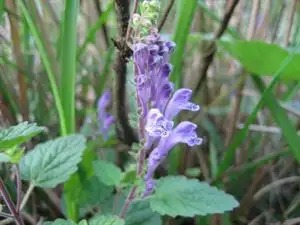
042. Han Xin Grass
Lamiaceae, Scutellaria
Alias: Dali Grass, Ear Pick Grass, Golden Teaspoon, Da Han Xin Grass, Shunjing Grass, Spoon Grass, Red Leaf Plow Tip, Indian Scutellaria, Large Leaf Scutellaria, Laughing Herb, Tiger Bite, Xiangtianzhan, Scutellaria, Ear Flower, Longyou Herb, Hook Head Line.
Perennial herb, growing in wet places beside ponds, fields or roadsides. Distributed in Jiangsu, Guangxi, Guangdong, Sichuan, Hebei, Shanxi, Shaanxi, Hubei, Anhui, Jiangxi, Zhejiang, Fujian, Guizhou, Yunnan, Taiwan, Henan and other places.
Han Xin Grass - Folk Legend: Folk legend says that Han Xin was beaten by several scoundrels while selling fish in the market and was bedridden. The neighbor aunt saw the disease and got a kind of herb from the field to boil soup for him to heal his wounds. After a few days, his wounds healed. Later, Han Xin joined the army and became a general. At that time, the battle was fierce and there were many wounded. He sent people to the fields to collect the herbs that the neighbor's aunt used to treat his wounds, and boiled them in a big pot for the wounded to drink. As a result, the wounded recovered quickly. Someone asked what the name of such a magical herb was? Han Xin didn't know. Someone said: "Then call it 'Marshal Grass'!" But someone objected: "Hundreds of years later, who knows which marshal it was, just call it 'Han Xin Grass'!" Since then, the name of Han Xin Grass has been passed down to this day.
Functions and indications: clearing heat and detoxifying; promoting blood circulation and relieving pain; stopping bleeding and reducing swelling. Mainly used for carbuncle, carbuncle, lung carbuncle, intestinal carbuncle, scrofula, snake bites, lung heat cough and asthma, toothache, throat paralysis, pharyngitis, muscle and bone pain, vomiting blood, coughing up blood, blood in the stool, bruises, traumatic bleeding, and skin itching.
Note: Pregnant women should take it with caution.
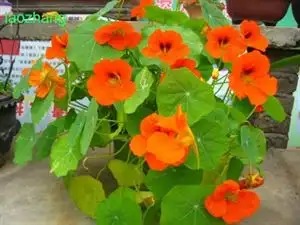
043. Nasturtium
Ranunculaceae, Nasturtium
Alias: Nasturtium, Nasturtium, Nasturtium, Golden Lotus, Golden Hibiscus, Golden Plum Grass, Indian Water Celery, Big Red Cardinal
Nasturtium is a slightly fleshy herb, often cultivated as an annual or biennial herb, with a slender stem, hollow flesh, semi-climbing or procumbent, gray-green, up to 1.5 meters long; flowering period July-August. Native to Central and South America, it likes a cool, humid environment and is mostly grown as a perennial herb in alpine meadows or sparse woodlands above 1,800 meters above sea level. It is often cultivated as an annual or biennial flower in the north.
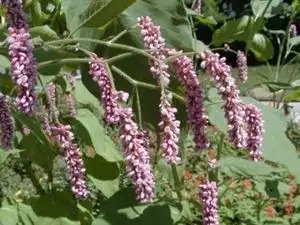
044. Polygonum rubrum
Polygonaceae, Polygonum
Other name: dogtail flower.
Annual large herb, racemes terminal or axillary, soft and drooping like spikes, small flowers pink or rose red, flowering period July-September. Distribution habit: native to Australia. Likes warm and humid environment, likes sufficient sunlight; suitable for planting in fertile and humid land, also resistant to barrenness, strong adaptability.
Garden use: can be used as a background plant in flower borders, lawns, lakeside, etc., a piece of pink, very moving. Can also be used as cut flower material.
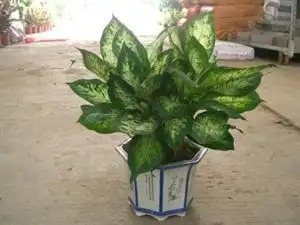
045. Dieffenbachia
Dieffenbachia genus, Araceae
Evergreen shrubby herb, with broad yellow-green leaves with white or yellow-white dense irregular spots, and some golden leaves with green edges. The color is bright and strong, with high ornamental value. It is one of the most respected indoor foliage plants.
There are 30 species of plants in the same genus, native to tropical America. Commonly cultivated ones include: 1. Rafflesia dieffenbachia; 2. Spray snowflake dieffenbachia; 3. Star-spotted dieffenbachia; 4. Dumb banana; 5. White-spotted dieffenbachia.
Variations, types, varieties: Horticultural variants include: (1) narrow-leaved dieffenbachia; (2) white-stalked dieffenbachia; (3) white-veined dieffenbachia; (4) spotted dieffenbachia; (5) milky-spotted dieffenbachia.
This species is a poisonous plant listed in the Plant Atlas Database. The whole plant is poisonous, with the stem being the most toxic, followed by the petiole and leaves. This plant is the most poisonous plant in the Araceae family. Its juice causes itching and dermatitis when it comes into contact with the skin. Swallowing a small tuber of the stem will cause extreme stinging in the mouth and throat, and paralysis of the vocal cords, so it is called a "dumb stick"[37]. There are also burns, edema, and excessive salivation on the surface of the lips and tongue, which affect swallowing and breathing. Symptoms can last for several days or more than a week. In severe cases, swelling of the mouth and tongue can cause suffocation. Nausea, vomiting, and diarrhea sometimes occur.
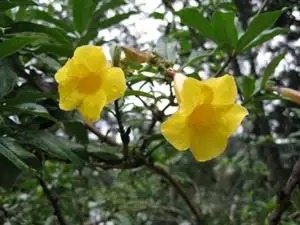
046. Yellow cicada
Apocynaceae, Yellow cicada
Evergreen shrub, flowering period April-December, native to Brazil.
There are two cultivated varieties: hard-branched yellow cicada and soft-branched yellow cicada. The plant is poisonous, so be careful. This species is a poisonous plant included in the plant atlas database, and its toxicity is that the plant's latex is poisonous. Symptoms of poisoning in humans and animals include increased heart rate, circulatory and respiratory system disorders. Pregnant animals will have miscarriage if they eat it.
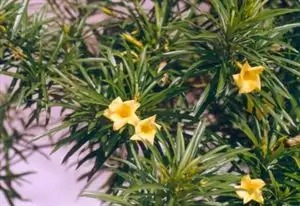
047. Yellow Oleander
Apocynaceae, Oleander
Alias: wine cup flower, Taiwan willow, willow wood, equal fruit, big flying acid, yellow flower champion bamboo, heartbreak grass
Large evergreen shrub or small tree, up to 4-5 meters high. Flowering period is from June to December, and fruiting period is from November to February of the following year. Native to tropical America, the West Indies and Mexico. Cultivated in Taiwan, Fujian, Yunnan, Guangxi and Guangdong. Greenhouse cultivation in the Yangtze River Basin and north of it. Used for viewing parks and gardens. Planted in clusters or along walls. The latex and seeds are poisonous and can be fatal if ingested. This species is a poisonous plant included in the plant atlas database. Its toxicity is that the whole plant contains rich latex, which is poisonous. The seeds are the most toxic, and ingestion can be fatal and can cause miscarriage. The main symptoms of poisoning by oral administration of the seeds include burning sensation in the mouth, stinging of the tongue, dry throat, vomiting, diarrhea, and dilated pupils. The effect on the heart is similar to that of digitalis, which first excites, then inhibits, and then paralyzes. Eating one seed for a child and 8-10 for an adult can be fatal. It is highly toxic. The seeds are also used as medicine, which can detoxify, reduce swelling, and strengthen the heart.
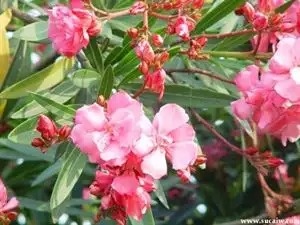
048. Oleander
Apocynaceae, Oleander
Also known as red oleander, willow-leaf peach, half-year red
Large evergreen shrub. Native to Iran, now widely planted in tropical and subtropical regions; cultivated in all provinces and regions. Often cultivated as an ornamental plant in gardens everywhere. The leaves are like willows and bamboos, the red flowers are bright, better than peach blossoms, the corolla is pink to dark red or white, with a special fragrance, and the flowering period is from June to October. The leaves of oleander have a strong resistance to sulfur dioxide, carbon dioxide, hydrogen fluoride, chlorine and other toxic and harmful gases to the human body, and are called "environmental protection guards" by people. This species is a poisonous plant included in the plant atlas database, and its leaves, bark and roots are poisonous. The fresh bark is more toxic than the leaves, and the toxicity is weakened after drying, and the flowers are less toxic. In the early stage of poisoning, the main symptoms are gastrointestinal symptoms, including loss of appetite, nausea, vomiting, diarrhea, abdominal pain, and then cardiac symptoms, including palpitations, slow and irregular pulse, premature contractions, and electrocardiogram with sinus bradycardia, atrioventricular block, ventricular or atrial tachycardia. Nervous system symptoms also include salivation, dizziness, drowsiness, and numbness of the limbs. In severe cases, the pupils are dilated, bloody stools, lethargy, convulsions and death. The symptoms of animal poisoning are similar. After cattle are poisoned, severe cases have cold skin, dilated pupils, cessation of appetite and rumination, palpitations, diarrhea, rapid pulse, and sudden death.
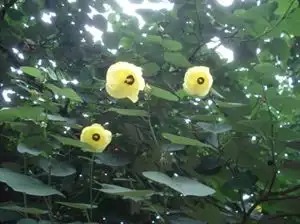
049. Hibiscus tiliaceae
Malvaceae Hibiscus genus
Large evergreen tree, up to 4-7 meters tall. Large, heart-shaped leaves with long stalks. Yellow flowers, bell-shaped corolla, capsule. In rural Taiwan, its leaves are often used to wrap rice dumplings, so it is also called cake tree.
Clears away heat and detoxifies, dissipates blood stasis and reduces swelling. Mainly used to treat cassava poisoning. External use to treat sores, boils, swelling and toxins.
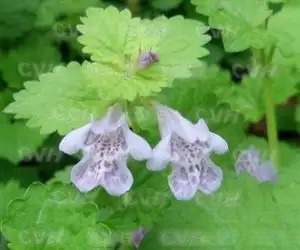
050. Tongquan Grass
Tongquan Grass Genus, Scrophulariaceae
Other names: Pus bubble medicine, Tangshi grass, pig pepper, wild field vegetable, goose intestine grass, green blue flower, five-petal plum, cat's foot, sharp board cat grass
Annual herb or biennial. Grown on sandy river banks, wet grasslands, grass slopes, ditches, and roadsides.
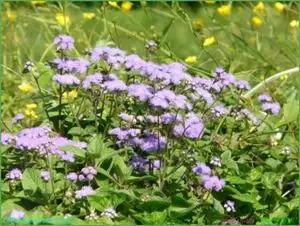
051. Ageratum
Asteraceae Ageratum
Also known as Ageratum
Annual herb, native to Mexico. It is distributed in areas from low altitude to 2,800 meters. It is cultivated in Guangdong, Guangxi, Yunnan, Guizhou, Sichuan, Jiangxi, Fujian and other places, and there are also naturalized wild distributions. It grows in valleys, under or on the edge of forests on hillsides, by rivers or hillside grasslands, on the edge of fields or on wasteland. It is only cultivated in Zhejiang and Hebei.
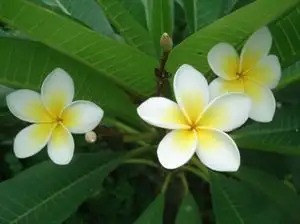
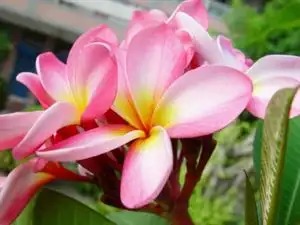
Red
052. Plumeria
Apocynaceae, Plumeria
Alias: Burmese Gardenia, Egg Yolk Flower, Big Season Flower, Indian Jasmine
Deciduous shrub or small tree. Flowering period: May-October. Origin and distribution: Native to Mexico, America. It has been introduced for cultivation. It is cultivated in Guangdong, Guangxi, Yunnan, Fujian and other provinces. It needs to be cultivated in greenhouses in the Yangtze River Basin and its northern areas.
National Flower and City Flower: It is the national flower of Laos. It is the city flower of Zhaoqing, Guangdong.
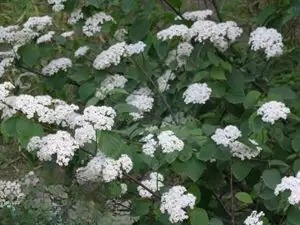
053. Viburnum
Caprifoliaceae Viburnum
Deciduous shrub, flowering period from May to June, fruit ripening from September to November.
Distribution: It is a native species, mainly produced in Zhejiang, Jiangsu, Shandong, Henan, Shaanxi, Hebei and other provinces. Viburnum has dense branches and leaves, and a spherical crown; the leaves are beautiful and turn red in autumn; when it blooms, white flowers cover the branches; when the fruit is ripe, the red fruits are pleasing to the eye. This tree with leaves, flowers and fruits is indeed an ornamental tree and a good material for making bonsai.
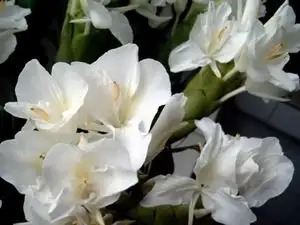
054. Ginger Flower
Ginger Flower Genus, Zingiberaceae
Other names: Butterfly Ginger, Spike Flower Kaempferia, Butterfly Flower, Fragrant Snow Flower, Night Cold Su, Ginger Orchid, Turmeric
Perennial herb. Flowering period is May to November. The plant is 1 to 2 meters tall. The underground stems grow horizontally in tubers and are fragrant, shaped like ginger. Produced in Sichuan, Yunnan, Guangxi, Guangdong, Hunan and Taiwan.
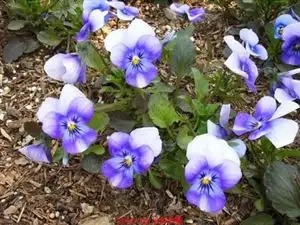
055. Viola
Violaceae, Viola genus
A monophylic or diphytic herb native to Northern Europe, the Pyrenees Mountains of Spain. The plant is 10 to 30 cm tall, with a short, upright stem and a flower diameter of 2.5 to 4 cm. There are about 500 species in the same genus, most of which are horticultural varieties. The flowers are purple, white, yellow, blue, purple, etc., and are nearly round. The flowering period varies depending on the time of cultivation.
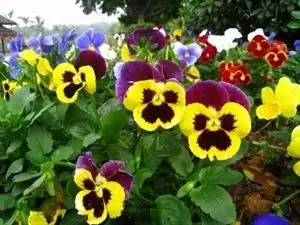
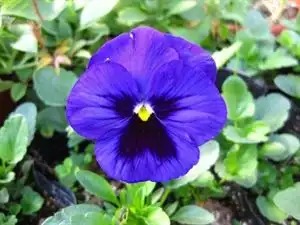
056. Pansy
Violaceae, Viola
Alias: human face flower, cat face flower, sun butterfly flower, butterfly flower, ghost face flower
[National flower of Iceland]: Pansy is a native flower of Iceland and is designated as the national flower.
Originally from Europe, it is now distributed all over the world. Pansy is one of the main flowers for arranging spring flower beds.
In addition: The difference between pansy and pansy: The flowers of pansy are much larger than those of pansy. It is difficult to distinguish in the picture, but it will be easier to recognize in person.
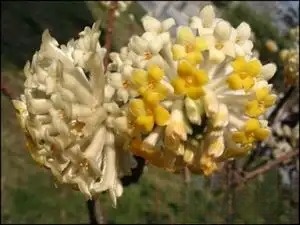
057. Osmanthus fragrans
Other names: knotted tree, yellow daphne
Deciduous shrub. It is a common early spring flower in the garden. After the leaves fall in late autumn, the branches and tips droop and form buds, which bloom before the leaves in the next spring. It is distributed from Henan and Shaanxi in the north to all provinces and regions south of the Yangtze River in the south.
It is said that in some places, Osmanthus fragrans is called "dream flower". In fact, the flowers of Osmanthus fragrans are not noticeable. I heard from the old people that this tree can interpret dreams. If you have a dream at night, get up early in the morning and tie a knot on its branches when no one is looking. If it is a good dream, it can come true, and if it is a bad dream, it can be resolved. Therefore, this tree is called "dream tree", and the flower naturally becomes "dream flower".

058. Golden bud flower
Acanthaceae, Monophyllum
Other names: Brilliant bud flower, variegated acanthus, yellow shrimp flower, golden bud shrimp flower
An evergreen subshrub, flowers bloom in summer and autumn, terminal, golden buds, long-lasting flowering, beautiful flowers and leaves. Golden bud flower is native to Peru and Mexico.
The plants are neatly clustered, the flowers are bright yellow, and the flowering period is long. It is suitable for decoration of meeting places, halls, rooms and balconies. It is used to arrange flower beds in the south.
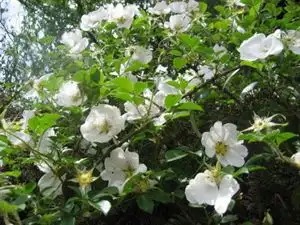
059. Golden Rosa Laevigata
Rosaceae, Rosa genus
Other names: sugar jar, thorn head, hanging hook, yellow tea bottle
Evergreen vine shrub, flowering in May, fruiting in September-October. Produced in southern parts of the province, wild on sunny hillsides; distributed in central, eastern, southern and southwest China.
Oral consumption of the fruit can promote gastric secretion, help digestion, and has astringent effect on intestinal mucosa, reducing secretion and stopping diarrhea. The decoction has an inhibitory effect on Staphylococcus aureus, Escherichia coli, Pseudomonas aeruginosa, Shigella dysenteriae, etc. It can reduce serum cholesterol in experimental animals and reduce the degree of atherosclerosis.
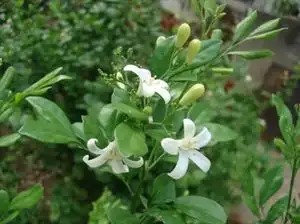
060. Osmanthus fragrans
Osmanthus fragrans, Rutaceae
Alias: stone pepper, Jiuqiuxiang, Jiushuxiang, Qilixiang, Qianlixiang, Wanlixiang, Guoshanxiang, Huangjingui, Shanhuangpi, Qianzhiyan
Evergreen shrub, sometimes grows into a small tree. Flowering period is July to October. The berries are nearly spherical, fleshy and red, and the fruit ripens from October to February of the following year. It is produced in Yunnan, Guizhou, Hunan, Guangdong, Guangxi, Fujian, Taiwan and other places, as well as some other tropical and subtropical areas in Asia.
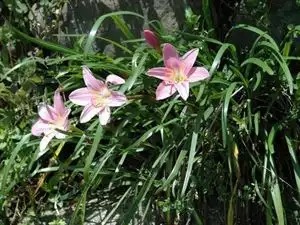
061. Chinese chives
Amaryllidaceae Allium genus
Other names: Chinese chives, red allium, Chinese chives, flower chives, red iris, red iris, false saffron, race saffron
Chinese chives bloom from April to September. Suitable for garden flowerbeds or potted plants.
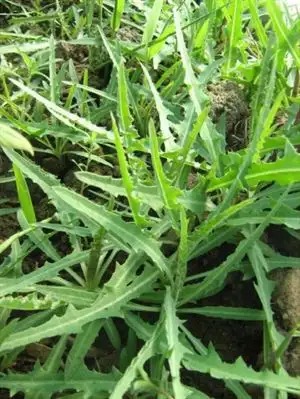
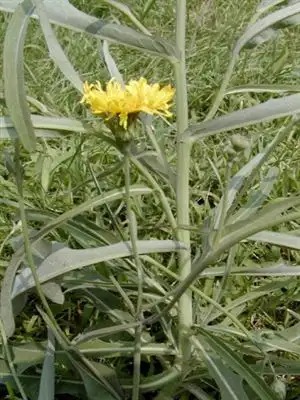
Flower
062. Sonchus
Asteraceae, Sonchus
Also known as bitter herb, bitter hemp seed, patrinia [in the north], small thistle [in Heilongjiang], bitter herb, and hemp vegetable.
Sonchus is mainly distributed in Northwest China, North China, Northeast China, etc. It grows wild on barren hillsides, beaches, and roadsides. In recent years, due to the increasing attention paid to the health function of Sonchus, artificial cultivation has begun in various parts of Shandong. Due to the salt-alkali tolerance of Sonchus, it is cultivated on a large scale in coastal and inland saline-alkali areas. Its winter cultivation can be put on the market during the Spring Festival and early spring vegetable off-season, and its commodity value is relatively high.
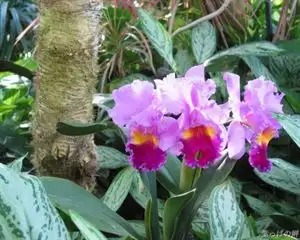
063. Cattleya "King of Orchids", "Queen of Orchids"
Orchidaceae, Cattleya
Also known as: Achaeme, Cattleya, Cattleya, Cattleya, Cattleya
A horticultural hybrid of the genus Cattleya, one of the most famous orchids in the world.
Cattleya has not been cultivated for a long time, and large-scale production has only been since the 1980s. However, it enjoys a high status in the flower market. It is highly favored by citizens. It has become one of the important flowers for giving to relatives and friends on festivals.
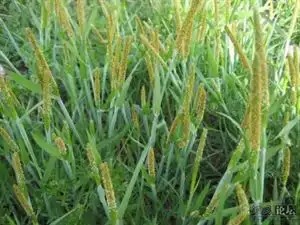
064. Alopecuroides
Gramineae Alopecuroides
Other names: Niutoumeng, Shangaoliang, Daobanggu
Annual herb. Flowering and fruiting period: April to August.
[Functions and indications] It can remove dampness, reduce swelling, and detoxify. It is used for edema and chickenpox; it can be used externally to treat diarrhea and indigestion in children.
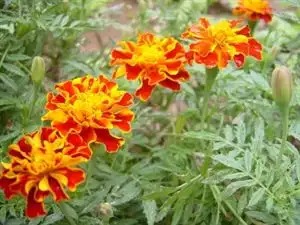
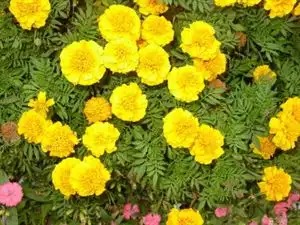
065. Marigold
Asteraceae Marigold
Other names: yellow chrysanthemum, five-petal lotus, old red, stinking chrysanthemum, peacock chrysanthemum, small marigold, red and yellow grass, satin flower.
Plant height 20-50cm, stem with purple. Leaves opposite or alternate, pinnately divided, linear-lanceolate, leaves with oil glands, odor. Capitulum solitary, flower diameter about 4cm; ligulate flowers yellow, base or edge reddish brown, flowering period June-September. Fruit ripening period September-October. Flowering period June-September.
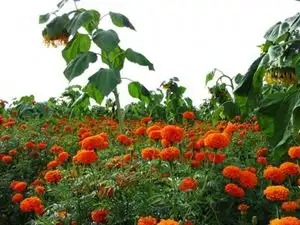
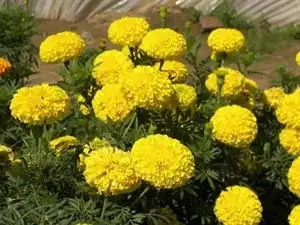
066. Marigold
Asteraceae Tagetes
Alias: stinking hibiscus, longevity lamp, honeycomb chrysanthemum, stinking chrysanthemum, scorpion chrysanthemum
Annual herb, 50-150 cm high. The stem is erect, sturdy, with thin longitudinal ridges, and the branches are flat upward. The leaves are pinnate, 5-10 cm long and 4-8 cm wide, the lobes are oblong or lanceolate, with sharp serrations on the edges, and the tooth tips of the upper leaf lobes have long fine awns; there are a few glands along the leaf margins. The head inflorescence is solitary, 5-8 cm in diameter, and the top of the peduncle is club-shaped and swollen; the involucre is 1.8-2 cm long, 1-1.5 cm wide, cup-shaped, with tooth tips at the top; the ligulate flowers are yellow or dark orange, 2.9 cm long, the ligules are obovate, 1.4 cm long, 1.2 cm wide, the base is contracted into long claws, the top is slightly curved and notched, the corolla of the tubular flowers is yellow, about 9 mm long, and has 5 tooth cracks at the top. Achenes are linear, with a narrow base, black or brown, 8-11 mm long, and covered with short pubescence; the pappus has 1-2 long awns and 2-3 short and blunt scales. Flowering period is June-September.
In addition: Maidenhair and marigold are very similar. The main differences are:
1. Maidenhair flowers are smaller than marigolds
2. Maidenhair is darker in color, dark red or dark yellow, while marigolds are brighter in yellow
3. Both have pinnate leaves, but the size of the leaves is obviously different: marigold leaves are 5-10 cm long and 4-8 cm wide; Maidenhair leaves are 2.5-5 cm long.
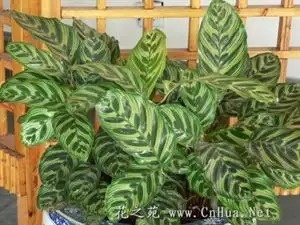
Peacock arrowroot
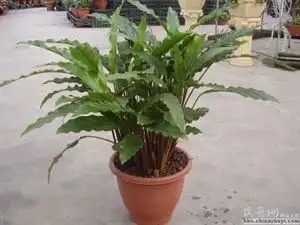
Wavy Arrowroot
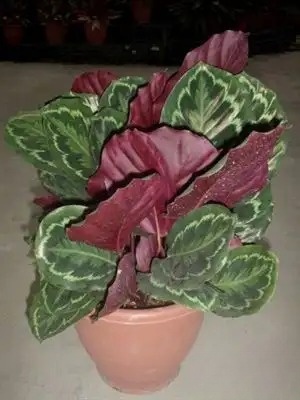
Rose Arrowroot
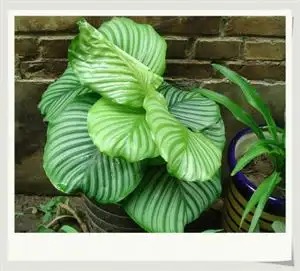
Green Apple Arrowroot
067. Peacock Arrowroot
Arthropodaceae, genus Ophiopogon
Other name: Five-color Kudzu Curcuma
Perennial evergreen herbaceous foliage plant
With tubers at the base, the plant is 30-50 cm tall. The leaves are ovate-elliptical, basal, entire, 20-30 cm long, about 10 cm wide, dark purple, with white hairs; because of the dense filamentous markings on both sides of the main veins on the leaf surface extending from the central vein to the leaf edge, arranged in a feather-like manner, and there are obvious small veins between the lateral veins that resemble peacock tail feathers, it is named Peacock Arrowroot; the ornamental spots on the back of the leaves are light purple, and the petioles are dark purple. The leaves have "sleep movements", that is, at night, the leaves extend from the leaf sheath to the leaves, folded in an egg-shaped shape, and unfold again after being exposed to sunlight the next morning.
In addition: Common arrowroot plants include Green Apple Arrowroot, Wavy Arrowroot, Rose Arrowroot, etc.
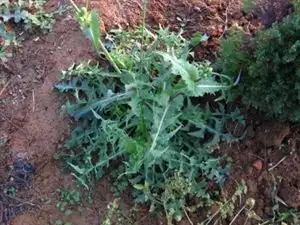
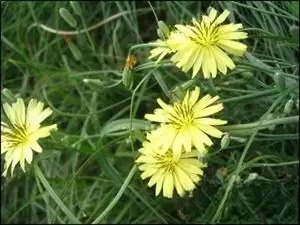
068. Sonchus
Depending on the region, the term "sonchus" refers to different plants. Generally, it refers to plants of the genus Sonchus in the family Compositae. According to the records, there are nine species in this genus, namely:
1. Sonchus oleraceus Linn.
2. Sonchus arvensis Linn.
3. Sonchus asper (Linn.) Hill.
4. Sonchus uliginosus M. B.
5. Sonchus brachyotus DC.
6. Sonchus lingianus shih
7. Sonchus transcaspicus Nevski
8. Sonchus asper (L.) Hill.
9. Sonchus palustris Linn.
In Shanxi, the fifth species, "sonchus brachyotus DC.," is commonly eaten as a wild vegetable, called bitter vegetable or sweet vegetable. In addition, in northern Shanxi, people in the Asteraceae family also eat bitter vegetable (Mulgedium tataricum (Linn.) DC.) as bitter vegetable, which is called bitter vegetable.
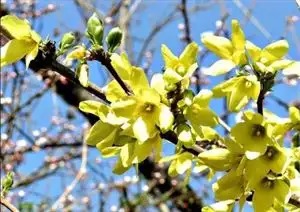
069. Forsythia
Forsythia genus, Oleaceae
Alias: a string of gold, dry lianzi, Huangqidan, Lianke, yellow flower strip, yellow chain flower, Qingqiao, Luoqiao, Huangshoudai, Huangshoudan, Huangjintiao.
A creeping deciduous shrub, 1 m-3 m high, with clusters at the base, arched and drooping branches, brown, tan or light yellow brown; twigs are earthy brown, slightly quadrangular, sparsely lenticel, hollow internodes, and solid pith at the nodes. Flowers: typical 4 flowers. Around March each year, the flowers bloom before the leaves and then gradually wither.
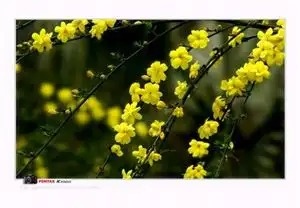
070. Yunnan Yellow Jasmine (Tanchun)
Oleaceae Jasmine
An evergreen vine-like shrub with glabrous twigs, square and shallowly ridged. Leaves are opposite, with 3 leaflets, oblong-lanceolate, one larger at the top, gradually narrowing to a short stalk at the base, and 2 smaller and sessile at the sides. Flowers are solitary, light yellow with dark spots, petals longer than the tube, often nearly double, and fragrant. Flowering period is March to April. The plant has strong sprouting ability.
 071. Welcoming Spring
071. Welcoming SpringOleaceae Jasmine/Jasmine
Alias: Winter jasmine, golden belt, string of gold, Yunnan winter jasmine, large-leaf winter jasmine, evergreen vine-like shrub, winter jasmine willow
Deciduous shrub, 40-50cm tall. Branches are slender and arched, quadrangular, green. Leaves are opposite, with 3 leaflets, ovate to oblong. Flowers are solitary. They bloom before leaves. Flowering period is February-April. Usually fruitless. Winter jasmine has long and weak branches, drooping or climbing, with green leaves and yellow flowers. It can be planted on embankments, terraces and the edge of the front of the steps.
In addition: the differences between the three:
1. Forsythia suspensa has 4 petals
2. Yunnan yellow jasmine (Tanchun) has terminal cymes
3. Winter jasmine has 6 petals, solitary, yellow, high-footed saucer-shaped, and grows in the axils of the first-year branches.
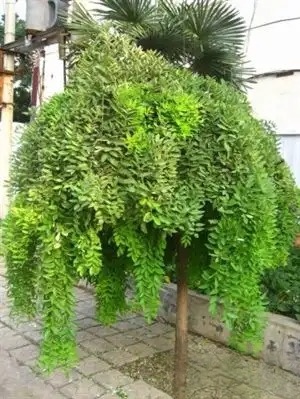
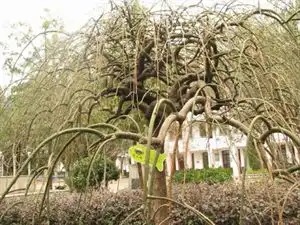
When the leaves fall off in winter
072. June Snow
Rubiaceae June Snow Genus
Other names: Gypsophila, Broken Leaf Holly, White Horse Bone, Ximing
An evergreen shrub with a low plant height of less than 1 meter and many dense branches that appear chaotic. It is mainly distributed in southeastern and central provinces such as Jiangsu, Zhejiang, Jiangxi, Guangdong, and Taiwan. It is also distributed in Japan. In southern gardens, it is often planted in the open air under the canopy and in the bushes; in the north, it is mostly potted for viewing and overwintering indoors. It is also a good bonsai material.
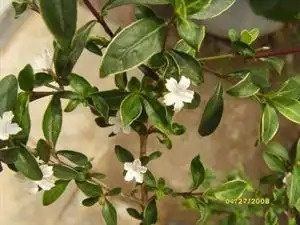
073. Sophora japonica
Leguminosae, Sophora japonica
Other names: Weeping Sophora japonica, Pan Sophora japonica
Deciduous tree. It is a bud mutation of Sophora japonica.
It is produced in North and Northwest China. It is introduced and planted in Fushun, Tieling, Shenyang and areas south of it. Sophora japonica has high ornamental value. Since ancient times, it has been planted symmetrically on both sides of temples, halls and other buildings to embellish the garden. During festivals, if colorful lights are hung on the tree, it will look more magnificent. If it is viewed in a short-stem pot, it will make people feel soft and unrestrained. In the flowering season, the beige inflorescence covers the branches, like a yellow umbrella covering the eyes, which is more beautiful and lovely.
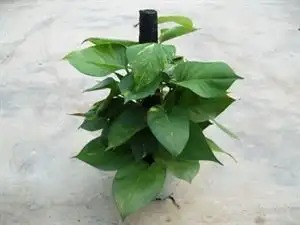
074. Pothos
Araceae Philodendron
Also known as Golden Pothos
A climbing foliage plant native to tropical rainforests. It has strong winding ability and well-developed aerial roots. It can be placed on a column made of palm leaves in the hallway or hotel, or it can be cultivated into a hanging shape and placed in a study or window sill. It is a flower that is more suitable for indoor placement.
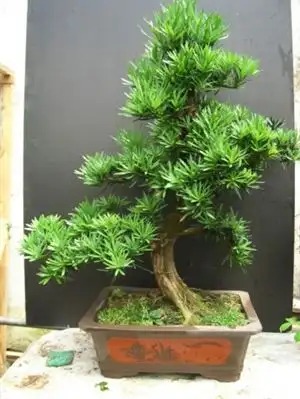

Fruit
075. Podocarpus
Podocarpaceae, Podocarpus
Evergreen tree, flowering in May, seed ripening in October. Produced in Jiangsu, Zhejiang, Fujian, Anhui, Jiangxi, Hunan, Sichuan, Yunnan, Guizhou, Guangxi, Guangdong and other provinces, cultivated in provinces south of the Yangtze River. Also distributed in Japan.
The magical and interesting thing about Podocarpus is that in the axils of the leaves of female trees in summer, small arhat-like seeds will be produced. The "bald" part on the seed is a lateral ovule, and the seed tray below is like the body of the arhat. The slightly raised part of the seed tray looks like the arhat's "hands together". When the seeds mature, the color of the seed tray will change from green to yellow, from yellow to red, and finally to purple-brown, like an arhat wearing a colorful robe, hence the name "Podocarpus". When the season of maturity comes, the Arhat tree is covered with seeds that dot the branches, and the tree is full of "green Arhat", "yellow Arhat", "red Arhat" and "purple Arhat", which is breathtaking.
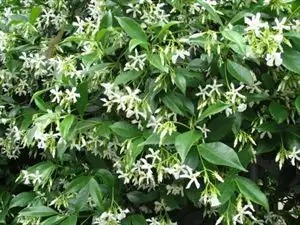
076. Trachelospermum
Apocynaceae Trachelospermum
Other names: Stone Dragon Vine, Wan (卐) Flower, Wan Zi Jasmine
Evergreen vine with aerial roots, often climbing trees and rock walls; blooms white flowers in early summer in May, with a high-footed saucer-shaped corolla, 5-lobed, and the lobes are arranged in a spiral shape, slightly resembling the "卐" character, and fragrant. Other commonly cultivated species include variegated Trachelospermum, which has white or milky yellow spots on the leaves and a red halo; small-leaved Trachelospermum, with small, narrow lanceolate leaves.
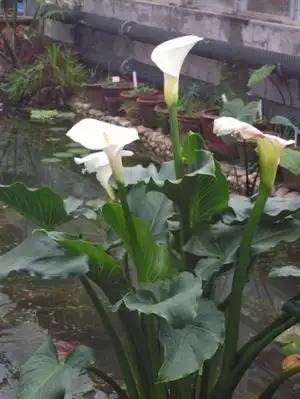
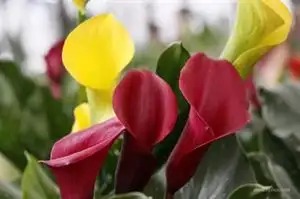
Color
077. Calla Lily
Araceae Calla Lily
Alias: Arrowhead Flower, Water Calla, Guanyin Lotus
A bulbous flower, Calla Lily is native to rivers or swamps in southern Africa. It is distributed in Hebei, Shaanxi, Jiangsu, Sichuan, Fujian, Taiwan, and Yunnan.
White Calla Lily is elegant and beautiful, and its flower language is "loyalty and eternal love".
Red Calla Lily symbolizes holiness and piety, eternal love, and good luck. Flower language: pure, like.
Pink Calla Lily symbolizes: love you forever
It is one of the emerging flowers in recent years. As a fresh cut flower, the market demand is large and the prospects are broad. Because Calla Lily has green leaves, white and large bracts, like a horse hoof, and a peculiar shape, it is an important cut flower at home and abroad and has a wide range of uses.
Note: Calla Lily is poisonous and contains a large amount of herbal calcium crystals and alkaloids. Ingestion by mistake can cause poisoning symptoms such as drowsiness. This species is a poisonous plant listed in the Plant Atlas Database. Its toxicity is that the tuber, spathe and spadix are poisonous. Chewing a small piece of the tuber can cause tongue and throat swelling and pain.
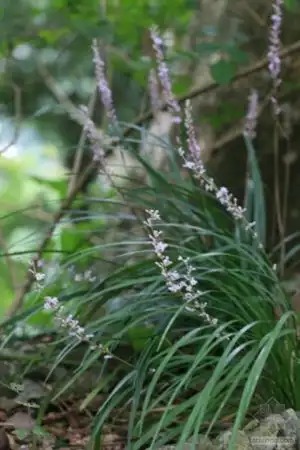
078. Ophiopogon japonicus
Liliaceae Ophiopogon japonicus
Also known as Ophiopogon japonicus and Ophiopogon japonicus
Perennial evergreen herb. The fibrous roots are relatively thick, and the top or middle of the roots often swell into spindle-shaped fleshy pieces.
Ophiopogon japonicus plants are evergreen all year round, have a wide ecological adaptability, can grow well in both shade and sun, and are easy to reproduce. They are ideal foliage ground cover plants.
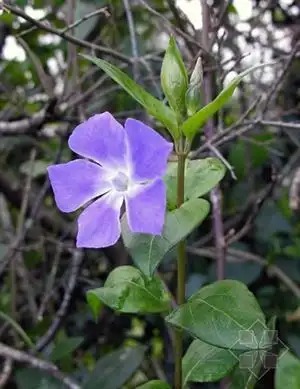
Vinca
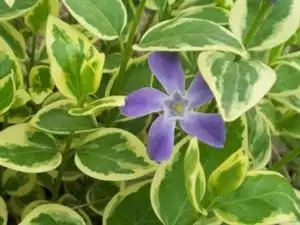
Vinca rosea
079. Vinca
Apocynaceae, Vinca genus
Other names: Vinca rosea, Vinca rosea
An evergreen vine subshrub, growing in clusters. The nutrient stems are prostrate or lying flat on the ground. Vinca rosea is often cultivated as ground cover in East China. It grows rapidly in deep soil in semi-shaded and moist places. It can take root between branches and nodes and quickly cover the ground. Its variegated and leafy varieties are mostly used as potted plants for viewing. Vinca rosea is an excellent ground cover plant material. It can be planted in patches at the edge of a forest or under a forest. It is especially suitable for planting on building bases and slopes, which is conducive to soil and water conservation.
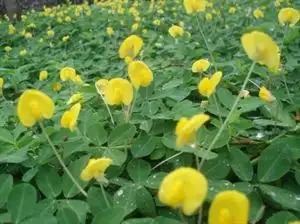
080. Peanut
Parachis genus, Fabaceae
Perennial herb, native to tropical Asia and South America, with alternate compound leaves and two pairs of obovate leaflets. Stem is creeping, about 10-15 cm tall, creeping. Flowers are axillary, butterfly-shaped, golden yellow, flowering from spring to autumn.
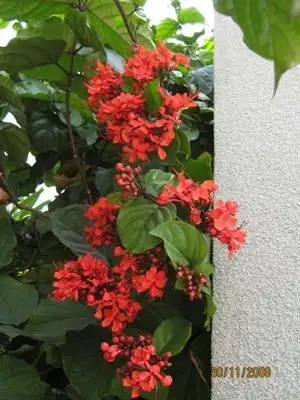
081. Stinking Peony
Verbenaceae, Verbena genus
Also known as beautiful tung, fragrant flower, 100-day red, red bud flower, champion red
Deciduous small shrub, 1-2 meters high, young branches slightly hairy, pith solid. Leaves have a strong odor. Red young branches slightly hairy, white pith solid inside branches. Cymes are compact, corolla light red or red, purple, and smelly. Distributed in Hebei, Henan, Shaanxi, Jiangsu, Anhui, Zhejiang, Jiangxi, Hubei, Hunan, Sichuan, Yunnan, Guizhou, Guangdong and other provinces.
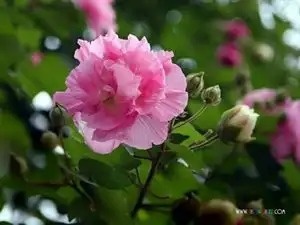
Double Hibiscus
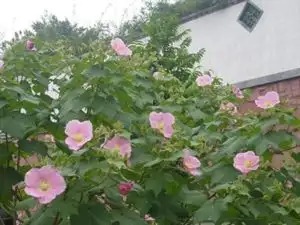
Single-petal hibiscus
082. Hibiscus
Malvaceae, Hibiscus
Alias: hibiscus, frost-resistant flower, Magnolia, ground hibiscus, Huamu
Deciduous shrub or small tree, flowering period from August to October.
White hibiscus: white flowers;
Pink hibiscus: pink flowers;
Red hibiscus: bright red flowers, large double petals, similar to peony;
Yellow hibiscus: also known as yellow mold, yellow flowers, bell-shaped, dark purple core, large double petals, similar to peony, a rare variety;
Drunken hibiscus: also known as "three drunken hibiscus", white flowers in the early morning, pink flowers at noon, and dark red in the evening, a rare and precious variety.
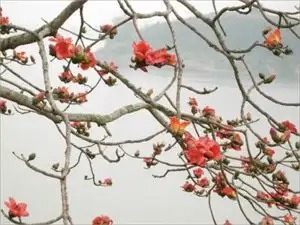
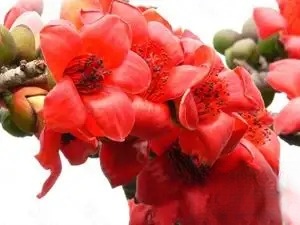
Flower close-up
083. Kapok (city flowers of Guangzhou and Kaohsiung, city flower of Kaohsiung, Taiwan, national flower of Argentina)
Bombacaceae, genus Kapok
Also known as red cotton, hero tree, Panzhihua
Large deciduous tree, tall, majestic, with spreading branches, blood-red flowers, as big as cups. Because it grows flower buds first and then leaf buds, when it blooms, the leaves that fell off in winter have almost not grown out. From a distance, it looks like a group of flames burning and jumping happily on the branches, which is very imposing. Therefore, it has always been regarded as a symbol of heroism. It is distributed in Fujian, Guangxi, Guangdong, Guizhou, Sichuan, Yunnan and other provinces and regions.
From ancient times to the present, the Dai people in Xishuangbanna have made ingenious and full use of kapok: in ancient Chinese books, Dai brocade has been mentioned many times, which is made of kapok fruit fluff, called "Tongjin", which is famous in the Central Plains; the fluff or fiber of kapok is used as the filling material of pillows and mattresses, which is very soft and comfortable; on the table, dishes cooked with kapok petals also appear from time to time; in addition, in Dai love songs, girls often praise their beloved boys as tall kapok trees.

084. Araucaria One of the world's top five park tree species
Araucaria genus, Araucaria family
Other names: scaly-leaved Araucaria, pointed-leaved Araucaria, Ken's Araucaria
An evergreen tree native to Norwalk Island, Australia, Araucaria is a beautiful landscape tree that can be planted alone, in rows, or in a grove. It can also be used as a background tree for large sculptures or landscape architecture. Potted seedlings used to decorate the environment in the front yard or hall can appear very elegant.
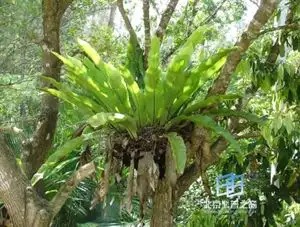
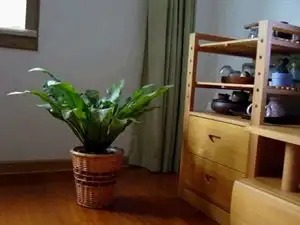
Potted plants
085. Bird's nest fern
Alias: nest fern, mountain fern, crown fern
Often epiphytic on tree trunks in rainforests or monsoon forests or on rocks under the forest. The clustered bird's nests can absorb a large amount of dead branches and leaves, bird droppings and rainwater, which are converted into humus and can be used as their own nutrients. At the same time, they can also provide settlement conditions for other tropical epiphytes, such as orchids and other tropical epiphytic ferns. Its ecological habits are that it likes high temperature and humidity and is not resistant to strong light.
Distribution: Bird's nest fern is native to tropical and subtropical regions, and is distributed in Guangdong, Guangxi, Hainan and Yunnan, as well as other subtropical regions.
Common varieties include: Taiwan bird's nest fern, feather-leaf bird's nest fern, round-leaf bird's nest fern, fishtail bird's nest fern, wrinkled bird's nest fern.
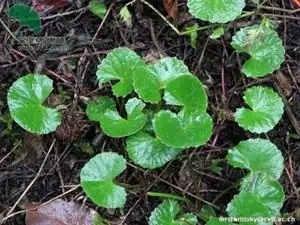
086. Centella asiatica
Apiaceae Centella asiatica
Alias: Luodeda, Bengdawan, Lianqiancao, Diqiancao, Tongqiancao, Tiedazhan, Banbianwan, Touguxiao, Daqiancao, Banbianqian, Dengzhancao, Matiucao, Biandixiang, Guankecao
Perennial creeping herb, mostly grown in slightly moist and fertile land beside roadsides, ditches, and field ridges. Distributed in Jiangsu, Anhui, Zhejiang, Jiangxi, Hunan, Hubei, Sichuan, Guizhou, Yunnan, Fujian, Guangdong, Guangxi and other places.
[Functions and indications] Clearing heat and dampness, detoxifying and reducing swelling. Used for damp-heat jaundice, heatstroke diarrhea, sand stranguria, blood stranguria, carbuncle, sore, and fall injuries.
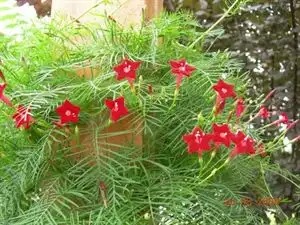
087. Morning glory
Convolvulaceae, Ipomoea genus
Other names: Feathered morning glory, dense morning glory, wandering dragon grass, morning glory, brocade screen seal, commonly known as five-pointed star flower, lion grass
Annual climbing flower, flowering period is almost the same as morning glory, but because of its slender plant, it is not like morning glory, which is often placed on high fences. It is generally used to arrange low walls and short fences, or green balconies. Its common variety is feathered morning glory.
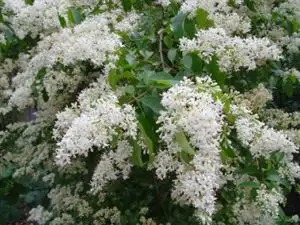
flower

Plant
088. Ligustrum lucidum
Ligustrum lucidum, Oleaceae
Other name: holly, wax tree, yew tree, yew tree or general tree
Evergreen tree with smooth gray bark. Branches spread and hairless. Leaves are leathery, broadly ovate to ovate-lanceolate. Inflorescence is terminal, flowers are white, drupes are oblong, blue-black. Flowering period is June to July. Originated in, widely distributed in the Yangtze River Basin and areas to the south, and also cultivated in North China and Northwest China. It can withstand low temperatures of around -10℃ and is a native tree species that is widely used in landscaping.

089. Paulownia
Paulownia genus, Scrophulariaceae
Other names: white-flowered Paulownia, big-fruited Paulownia, hollow Paulownia, water Paulownia, Paulownia tree, purple-flowered tree. Foxglove tree, royal Paulownia, queen tree
Deciduous tree. Native to, except for some species [white-flowered Paulownia P. fortunei (Seem) Hemsl.] distributed in Vietnam and Laos, all other species are endemic.
According to Japanese tradition, if a girl is born, a Paulownia tree will be planted in front of the house. When the daughter gets married, the wood of this Paulownia tree can be used to make a full set of dowry furniture for the daughter. However, people generally use harder wood to make furniture and are not used to using Paulownia wood. The Japanese also attributed the legend of the phoenix tree to the Paulownia, believing that the Paulownia tree will attract the phoenix. Although the two trees belong to different families, they have similarities, especially the Chinese characters "桐" in their names.
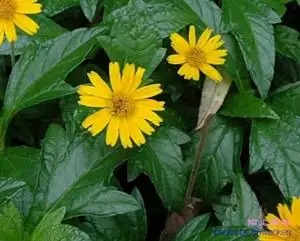
090. Wedelia sutchuenensis (one of the "100 most harmful invasive alien species in the world").
Wedelia sutchuenensis, Asteraceae
Other names: ground brocade flower, ground dragon
Perennial herb, origin: tropical America; widely naturalized in tropical areas around the world. Current distribution: Hong Kong, Guangdong, Hainan, Taiwan, Fudi (southern part).
Reasons for introduction and spread: It was introduced and cultivated as a ground cover plant in the 1970s. At present, it has grown continuously and become a garden weed in some places in southern China. It often grows in patches, encroaching on grasslands and wetlands, and lining up local plants.
Control methods: Pull out before fruiting; spraying of large-scale control with the herbicide metsulfuron methyl has good results. While controlling the above-ground part, the remaining underground stems should be pulled out in time.
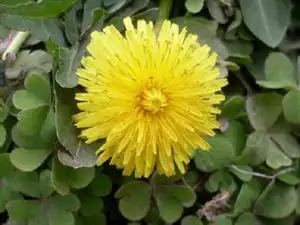
flower
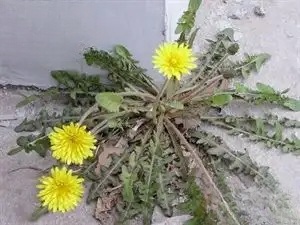
Plant
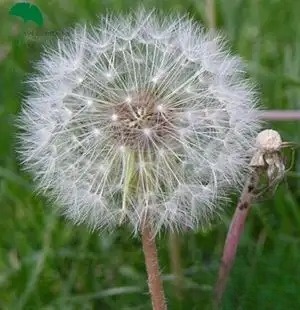
Fruit
091. Dandelion
Taraxacum genus of Asteraceae
A kind of annual or biennial herb. The flowering period is 3 to 8 months. It is native to Eurasia and was artificially introduced to America and Australia. The Compendium of Materia Medica records: "Dandelion is mainly used to treat breast abscesses in women. Drinking the decoction and sealing it will eliminate the symptoms immediately. It can eliminate food poisoning, disperse stagnant qi, clear away heat poisoning, transform food poisoning, eliminate malignant swelling, tuberculosis, and carbuncle." The small dandelion has the value of being eaten, used as medicine, and used as a plaything.
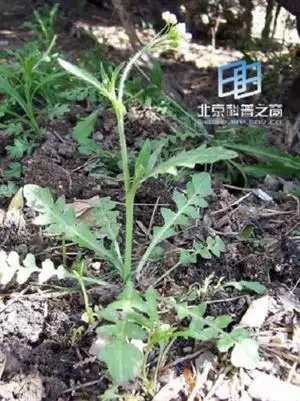
Plant
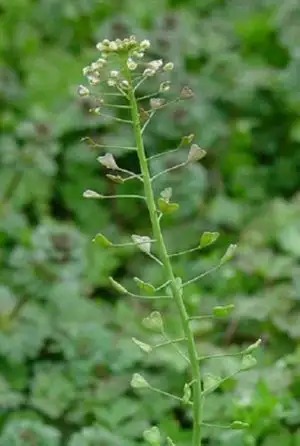
Fruit
092. Shepherd's purse
Cruciferae Shepherd's purse
Also known as life-saving grass, water chestnut vegetable
Originally, it is now distributed all over the world. People have been collecting wild shepherd's purse for consumption since ancient times. The records of shepherd's purse were found as early as 300 BC. Shepherd's purse has high medicinal value. The whole plant is used as medicine, which has the effects of improving eyesight, cooling, relieving fever, diuresis, and curing dysentery. Its flowers and seeds can stop bleeding and treat hematuria, nephritis, hypertension, hemoptysis, dysentery, measles, dizziness and eye pain.
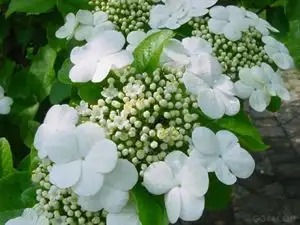
093. Viburnum
Caprifoliaceae Viburnum
Other names: wood hydrangea, hydrangea, butterfly flower, cow ear pearl
Semi-evergreen shrub. The inflorescence is surrounded by large white sterile flowers, and the middle is fertile flowers. The drupe is oval, first red and then fruit. Flowering period is April. Fruiting period is October-November. Viburnum is native to Jiangsu, Zhejiang, Hubei and other places. It is a warm temperate semi-shade tree species.
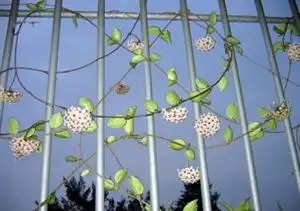
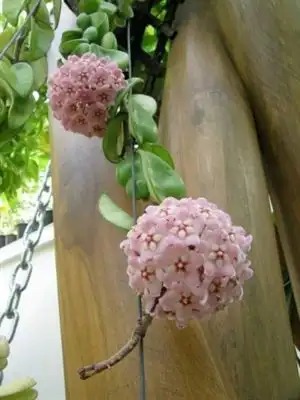
094. Hoya
Hoya genus, Apocynaceae
Alias: Tiejiabei, Jinxueqiu, Niu Tongue Huang, Shibimei, Jinsiye, Hydrangea leaf, Dashixiantiao, Climbing board, Straw sandal board, Yudiemei, Yudiemei, Bimei, Gumei, Hydrangea dragon, Thick-leaved vine, Dadou vine, Snow plum, Pneumonia grass
Epiphytic on trees or stones, with air roots on stem nodes. Flowering period is April-June and fruiting period is July-August. Distributed in Fujian, Taiwan, Guangdong, Guangxi, Yunnan and other places.
Functions and indications: Clearing heat and resolving phlegm; reducing swelling and relieving pain; promoting menstruation and lactation. Mainly used for epidemic encephalitis B; cough due to lung heat; carbuncle; low milk supply in lactating women; joint pain; orchitis; otitis media; mastitis; scrofula; low milk supply in parturients; blocked milk channels

095. Trumpet creeper
Bignonaceae, trumpet creeper
Other names: Bignoniaceae, centipede flower, hanging bell.
Deciduous woody vine. Flowering period is June to August, fruiting period is November.
Distributed in East China, Central China, South China, etc.; also found in Japan. Trumpet creeper is an ideal variety of vertical greening and beautification flowers and trees, and can be used for trellises, rockery, flower corridors, and wall greening. Its stems, leaves, and flowers can all be used as medicine, which has the function of purging blood heat and breaking blood stasis.
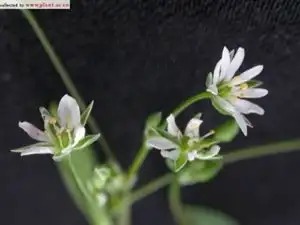
Flowers
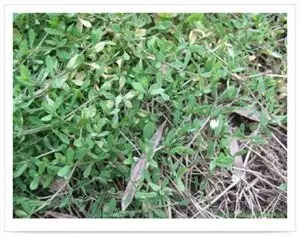
096. Chickweed
Caryophyllaceae, Chickweed
Other names: Chickweed, lime grass, cramp grass
Distributed in: Northeast China, Southwest China, South China.
Functions and indications: dispel wind and cold, strengthen tendons and bones, promote blood circulation and relieve pain, and detoxify. Indications: colds, rheumatic bone pain, sores, swelling, injuries, fractures, and snake bites.
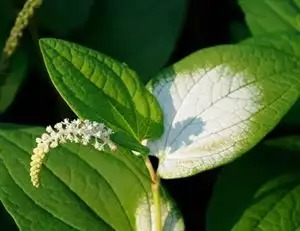
Leaves of Saururus chinensis
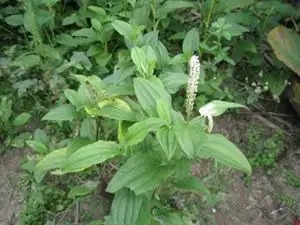
Plants of Saururus chinensis
097. Saururus chinensis
Saururaceae, Saururus genus
Other names: Wuluyebai, pondside lotus root, white lotus.
Perennial herb, flowering period from April to August, fruiting period from August to September. Grown in low-lying places such as ditches and swamps. Mainly produced in Jiangsu, Zhejiang, Hunan, and Guangdong. Distributed in provinces south of the Yangtze River Basin.
Functions and indications: clearing heat and promoting diuresis, detoxifying and reducing swelling. Used for urinary tract infection, nephritic edema, jaundice, athlete's foot, excessive leucorrhea in women; external use for furuncles, carbuncle, and skin eczema. The rhizome is used as medicine, which has the effects of reducing swelling, detoxification, and diuresis. People in Jiangsu boil the flower branches in water to treat fire stranguria and promote urination; the stems and leaves can be used as feed and pesticides; contains volatile oils and hydrolyzed tannins.
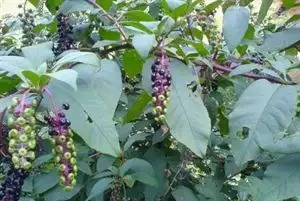
098. Phytolacca
Phytolacca genus, Phytolacca family
Other names: Night Call, Zhanglu, Danglu, Baichang, Zhangliu root, mountain radish, water radish, white hen, everlasting, ox radish, wet radish, downhill tiger, ox rhubarb, dog head Panax notoginseng, Jinqiniang, pig mother ear, golden chicken mother ground radish, local hen, local winter melon, etc.
Perennial perennial root herb, flowering and fruiting period is July to November, growing under sparse forests by the roadside, or cultivated in gardens. Mainly distributed in Henan, Anhui, Hubei and other places. Its roots can be used as traditional Chinese medicine and are included in the pharmacopoeia. It tastes bitter, cold in nature, toxic, and belongs to the lung, kidney, and large intestine meridians. It has the functions of expelling water and swelling, promoting bowel movements, detoxifying and dispersing knots. It is mainly used to treat edema, constipation, scrofula, sores, etc.
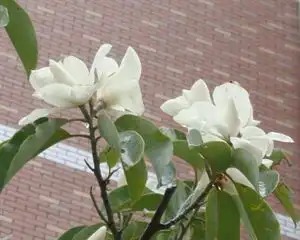
Michelia flowers in the mountains
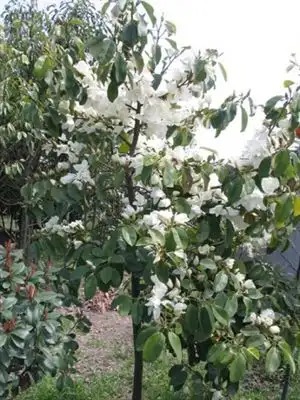
099. Michelia serrata
Magnoliaceae, Michelia genus
Other names: White Michelia glabra, Mo's Michelia
Evergreen tree, 20 meters high. Flowering period is February to March, fruiting period is September to October. Produced in Hunan, Guangdong, Guangxi, Fujian, Jiangxi, Guizhou and southern Zhejiang, the type specimen is produced in Hong Kong. It is an excellent early spring fragrant flowering tree species, and also an excellent garden and greening tree species.
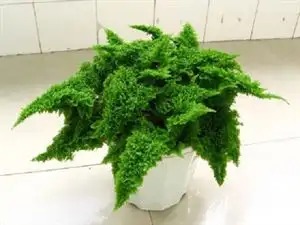
Nephrolepis serrata
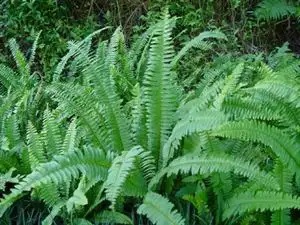
100. Nephrolepis
Nephrolepis genus, Nephrolepis family
Other names: centipede grass, round fern, comb grass, stone yellow skin
Often grows terrestrially and epiphytically in rock cracks and on tree trunks under streamside forests. It is native to tropical and subtropical regions, and is found in the wild in southern provinces such as Fujian, Guangdong, Taiwan, Guangxi, Yunnan, and Zhejiang. It is often found in streamside forests or in rock cracks or epiphytically on trees, and is mostly distributed in patches in the wild. It is currently an ornamental fern widely used at home and abroad.
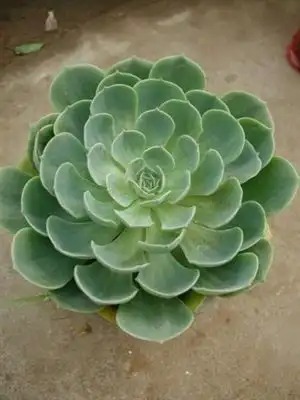
101. Echeveria
Echeveria genus, Crassulaceae
Alias: Echeveria palm, Lotus palm
Perennial fleshy herb with creeping stems. The leaves are densely clustered and erect in a rosette shape. The leaves are wedge-shaped and obovate, with short, sharp tips, hairless, and powder blue. The flower stems are soft, with bracts and white frost. 8--24 flowers form a cyme, with red corolla and lanceolate petals that do not open. Flowering period is July-October.
People often confuse Echeveria with Gem Flower. The difference is that the tip of the Gem Flower leaf is relatively round. The tip of the Echeveria leaf is pointed.
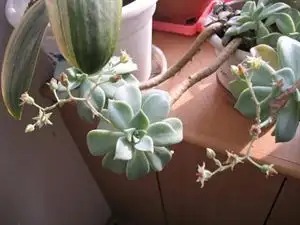
102.Gemstone Flower
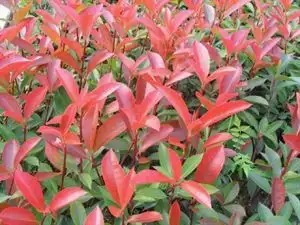
1
03.Heather
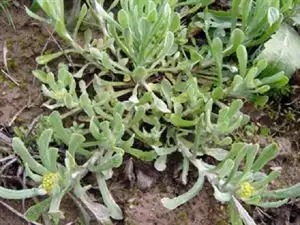
104.Artemisia serrata
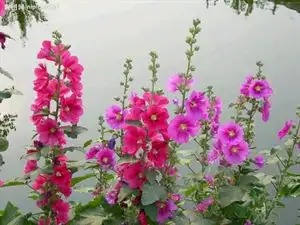
105.Hollyhock
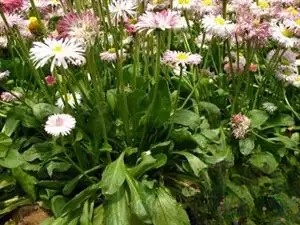
106.daisy
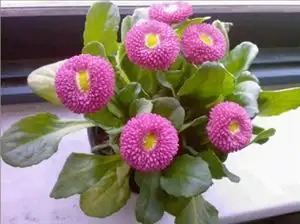
107.Cultivated daisy
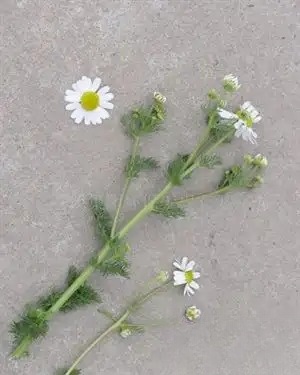
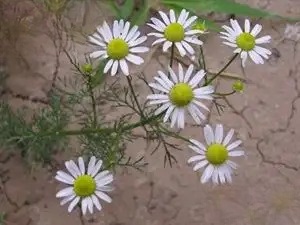
108.Matricaria
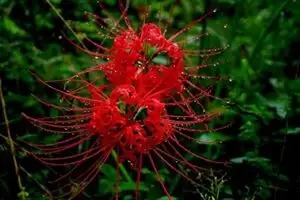
109.Red spider lily
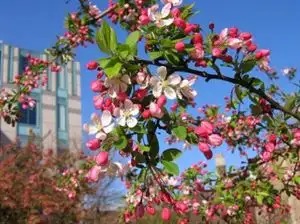
110.Weeping Begonia
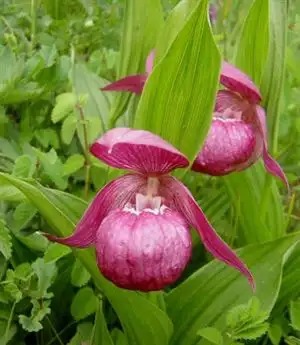
111.Cypripedium grandiflorum
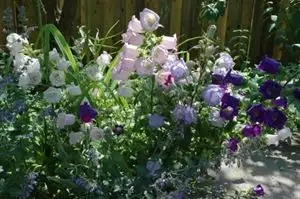
112.Bluebells
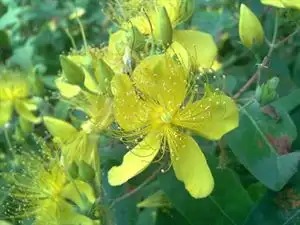
113.Hypericum
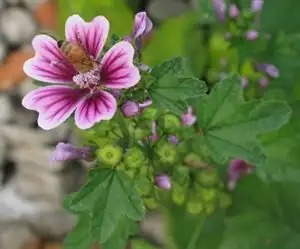
114.Mallow
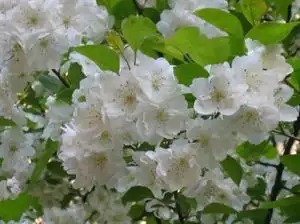
115.Pear Blossom
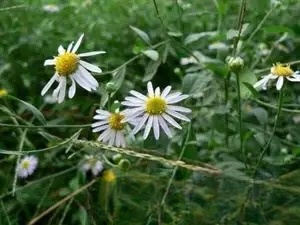
116.Malan
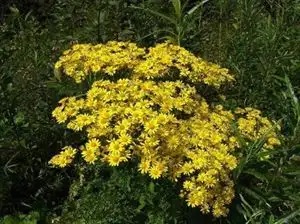
117.Senecio
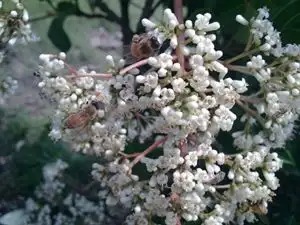
118.Coral tree flowers
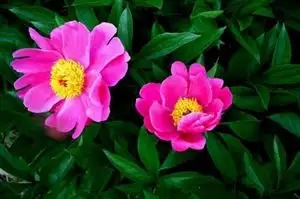
119.Peony
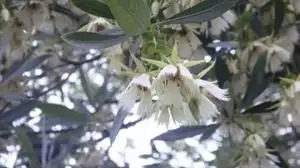
120.Ficus microcarpa
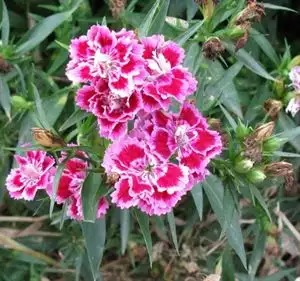
121. Dianthus
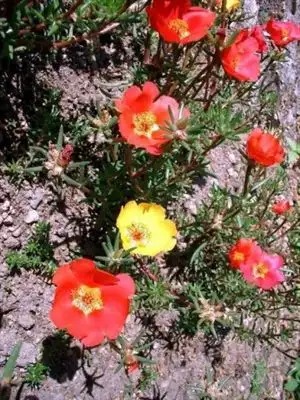
122. Sunflower or half lotus
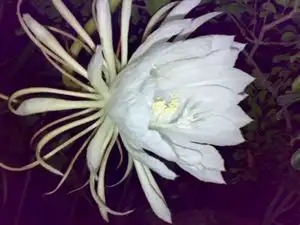
123. Epiphyllum
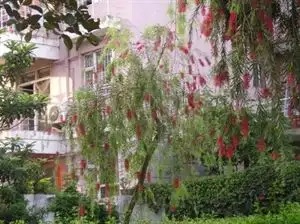
124. Callistemon
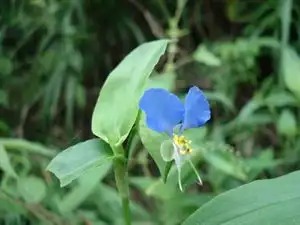
125. Commelina
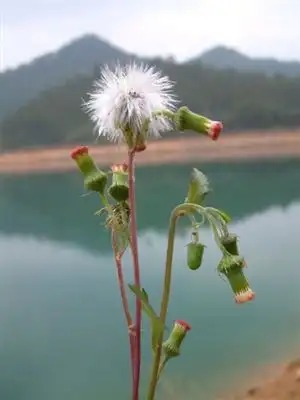
126. Chrysanthemum chinense
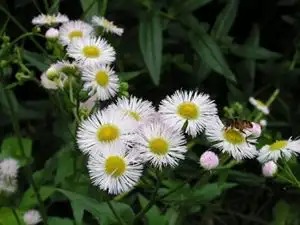
127. Fleece
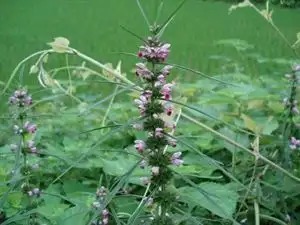
128.
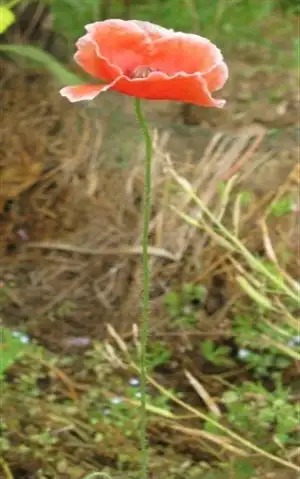
Leonurus 129. Corn poppy
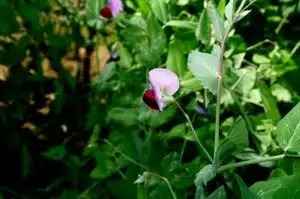
130. Purple pea flower
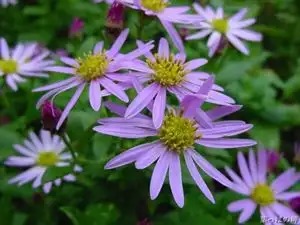
131. Aster wǎn